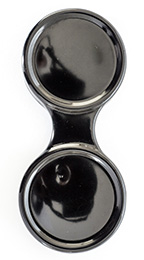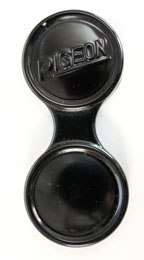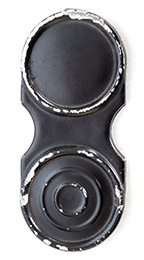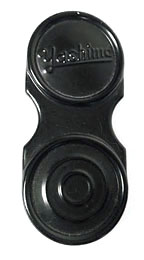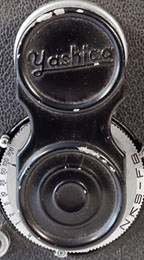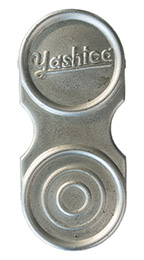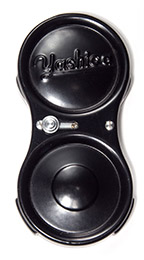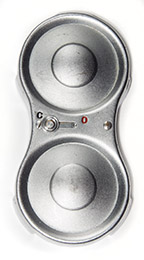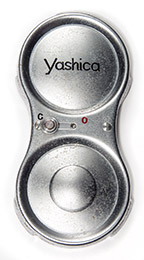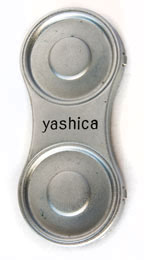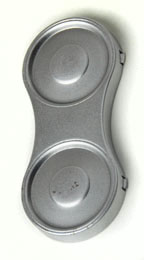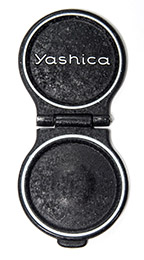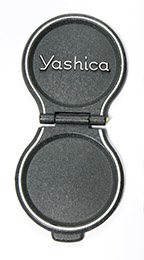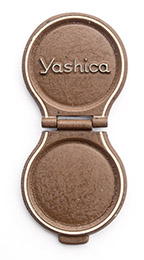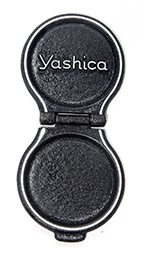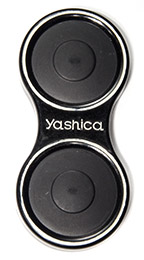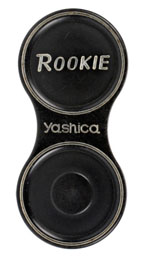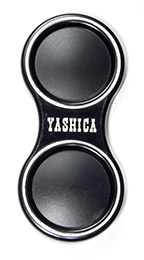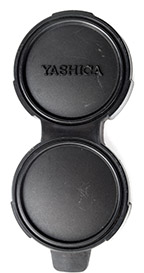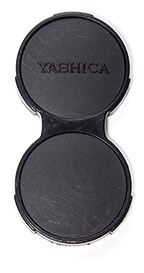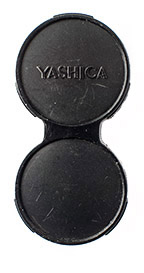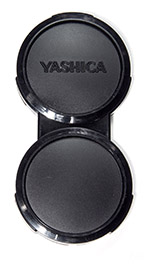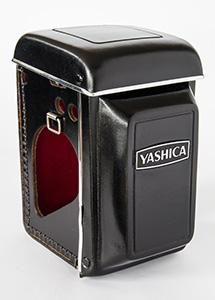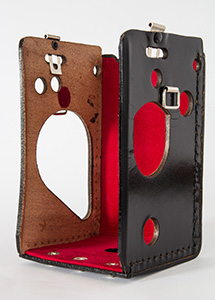Lens Caps, Cases & Boxes
Contents
(Scroll down or click on links.)
Pressed Metal Early Push-on (Yashima Pigeonflex)
Pressed Metal Early Push-on (Yashima Flex & Yashica Flex B)
Pressed Metal Bay 1 Sliding Lock (Yashicaflex S & C)
Pressed Metal Push-on (Yashicaflex A Series)
Cast Metal Hinged Bay 1 (66 & 44)
Hard Plastic Push-on
Soft Plastic Late Bay 1
Soft Plastic Push-on (Yashica E)
Buying
Case Straps
Case Retaining Screw/ Tripod Adaptor
Case Styles
Yashica 635 Compartment Case
Outer or Distribution Box
Inner Presentation or Storage Box
Inner Presentation or Storage Box 1950s to Early 1960s
Modern Product Box 1958 to 1986
Lens Caps
Lens caps are divided into ones designed to fit plain filter mounts (three separate sizes) and ones designed to fit Bay 1 mounts (the 44 Bay 1 mounts are spaced closer together with different bayonet alignment). The plain ones are the same 32 mm diameter on all the 66 cameras with simple arrangements, i.e., Pigeonflex, Yashima Flex, Yashica Flex B, Yashicaflex A-I, A-II, AS-I and AS-II and Yashica Rookie and Yashica A. The first of the cameras with plain filter mounts but with a panel around the lenses somewhat like Bay 1 models, the very rare Yashicaflex A-III, also has the standard 32 mm mounts but the later cameras have larger 36 mm diameter mounts. These are the Yashicaflex A2 and A (new model) and the Yashica B. The Yashica 44A has a smaller 28.5 mm mount.
Except for the earliest models, as with trim changes, lens cap design tended to change across models at the same time and at any given point, there was generally a single design for Bay 1 and another for push-on. Just as sometimes parts can be swapped around on Yashica TLRs, it's possible that lens caps are often lost or sold separately and owners replace with whatever they can find or fancy. My analysis of lens caps is based on many hundreds of cameras and perhaps surprisingly, by the far the majority are in character with the cameras that they are found on.
As with other design features, the Pigeonflex and metal Bay 1 lens caps were inspired by corresponding Rollei items.
Pressed Metal Early Push-on (Yashima Pigeonflex)
1953-54
Below right is a typical a push-on black painted pressed metal Yashima Pigeonflex lens cap with a very narrow waist and underlined “PIGEON” in capitals embossed at an angle across the viewing lens part (23 Yashima Pigeonflex cameras in my database have this style, see The Pigeon Loft page for Pigeonflex IA, IB and ID examples). However, the very earliest type may be the same style but without the Pigeon name. Three of the four earliest Pigeonflexes in my database with lens cap, including the earliest, have the plain type, the only jarring aspect is that the second earliest camera has the more typical variety. However, as that also features a late type ever-ready case, the two items may have been replaced. My plain example on the left is exceedingly glossy, albeit with a small dent in the lower part:
Pressed Metal Early Push-on (Yashima Flex & Yashica Flex B)
1953-54
The first type Yashimaflex lens cap is found on the earliest and fifth earliest Pigeonflex-like single word form “Yashimaflex” examples in my database. It is a push-on wide-waisted black painted metal lens cap without name. The second Yashima Flex lens cap is typical for the model and is the same except with “Yashima” embossed across the viewing lens part. The original Yashica Flex B lens cap is a very similar style to the Yashima Flex except for the new “Yashica” name. The otherwise identical silver (far right) version is found on the last three Yashica Flex Bs in my database with a lens cap:
( Image 1 is of Tom Heckhaus item, images 2 and 3 courtesy of Sandu Baciu)
Pressed Metal Bay 1 Sliding Lock (Yashicaflex S & C)
1954-57
The Yashicaflex S lens cap also changed from black to silver lens cap at around the time of the Yashica Flex B change:
Pictured first on the left is the black pressed metal Bay 1 lens cap with sliding lock from the Yashica Flex S with NKS-FB shutter and early Copal shutter versions. Next is the silver lens cap from a later Yashicaflex S, introduced with Copal shutter version with serial number 31xxx. The probable reason that there is no name is that the graphics of the Yashicaflex S nameplate no longer match the new style script found on other models. A very similar silver Bay 1 lens cap with “Yashica” printed across the viewing lens half in the new script style can be found on early Yashicaflex C examples which were released after the Yashicaflex S but then continued on concurrently. However, according to my database, later Yashicaflex C models, from about serial number 546xxx on (near the change from early to late focus knob type and the dropping of “Model C” from inside), are found with the plain silver Yashicaflex S type. It seems that Yashima may have decided to simplify production to one universal type.
Amongst the very earliest Yashicaflex C examples are two cameras with lens caps with “Yashica” across the viewing lens in red to match the red aperture scale, red DoF scale and red logos between the lenses and on the focusing hood. The one below belongs to the second earliest Yashicaflex C in my database with a lens cap, the other belongs to a camera with all the earliest features but no serial numbers visible.
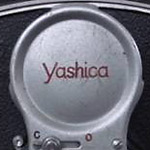 (Detail from larger web image)
(Detail from larger web image)
Pressed Metal Push-on (Yashicaflex A Series)
1954-56
The push-on metal lens cap below left is commonly found on Yashicaflex A-I, A-II, A-III and AS-II models and presumably was used on the AS-I model. The AS-II appeared to be in production longer than the others and very late ones come with the plastic, what is commonly thought of as, Yashica A type. There is a mix of types with very late A-I and A-II models so it is a little inconclusive whether the plastic or metal type are original for these cameras or the mix represents a cross over period. The rather rare MolfoReflex lens cap on the right doesn't have a name but is identical in all other respects:
(Right image courtesy of Göran Årelind)
Cast Metal Hinged Bay 1 (66 & 44)
1956-63
66 lens cap on left with thee 44 lens caps.
The hinged, cast metal Bay 1 lens cap on the left above was introduced with the new Yashica C and LM in 1956 and remained the standard fitting on all Bay 1 models until late 1963 (with the exception of late Yashicaflex S and C models which retained their earlier pressed metal types). The colour matched the camera metalwork - whilst black was standard for black framed cameras, Charcoal Gray, Burgundy (brown) and Golden Brown (light brown) versions can be found on the respectively coloured Yashica Ds. On the right are three 44 versions, with closer spacing and differing bayonet alignment, used on Yashica 44 and Yashica 44LM models. When buying, the 66 type are easy to tell apart from the 44 lens caps (white rings versus white outline respectively) - sellers are sometimes confused. Again, the colours of the 44 lens caps match the cameras, in this case a Yashica 44 Silver Gray and Golden Brown and a Yashica 44LM Charcoal Gray. Below are Burgundy, Rose Brown and Lavender Yashica 44 lens caps:
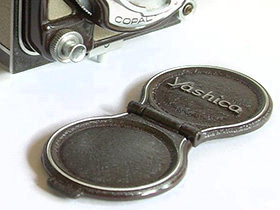

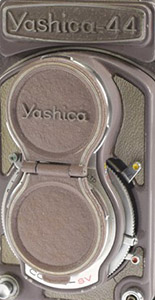
(Left image courtesy of Leigh Harris, centre is detail from larger web image, right image courtesy of Tom Heckhaus)
In my database are also Yashica 44s with matching Golden Brown, Rose Brown and Lavender lens caps but all the coloured ones are really rare, much more so than the cameras themselves seem to have become.
Hard Plastic Push-on
1956-68
(Second image courtesy of Tom Heckhaus)
Yashica A lens cap on left, Rookie in the middle and Yashica 44A on right.
The 32 mm Yashica A and Rookie lens caps were introduced in 1956 and appeared on all future plain filter mount models including the Yashicaflex AS-II which was still in production and maybe even the last of the A-Is and A-IIs. Those fitted to the very last of the Yashica A production in the late 1960s were basically the same but without the white rings:
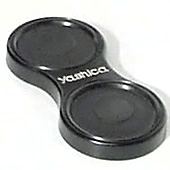 (Detail from larger web image)
(Detail from larger web image)
The material of the lens cap is a thick, hard plastic, reminiscent of bakelite. A blue felt ring insert is used to provide a snug interference fit at one end; taking lens end on my Yashica A lens cap and viewing lens end on my Yashica 44A lens cap. In my database are nine (at last count) grey Yashica A lens caps to match the grey metalwork of their A III cameras. The A III with black metalwork and grey leatherette has a black lens cap. This is the matching lens cap for a Burgundy (brown) Yashica A III:
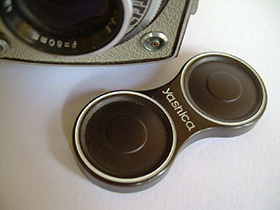 (Image courtesy of Leigh Harris)
(Image courtesy of Leigh Harris)
The push-on Yashica 44A lens cap is 28.5 mm. On Yashica 44As, the colour always matched the camera metalwork so there are also blue, red examples etc:
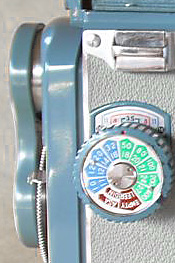 (Image courtesy of Leigh Harris)
(Image courtesy of Leigh Harris)
The main visual differences of the 44A lens cap to the Yashica A type, apart from size, is the script of the “Yashica” across the middle and the missing bumps.
The following example (front and inside views) is the 36 mm push-on lens cap from a Yashica B but this first appeared on the Yashicaflex A2 and then Yashicaflex A (new model). Visually, the style is identical to the 32 mm Yashica A lens cap:
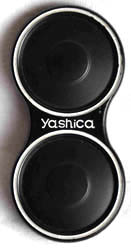
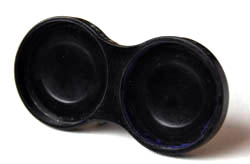
(Images courtesy of Göran Årelind)
Soft Plastic Late Bay 1
1963-86
The first soft plastic lens caps (left image) arrived in about September/October1963. These had a protruding tab at the base and pronounced ring depressions cast in much like the earlier hinged and plastic Yashica A types but without the colour. In about March 1965, the simpler and far more common type (second image) appeared. Although “Yashica” is no longer quite as cramped as in the narrow wild west style introduced in the late 1950s in marketing and between the camera's lenses, the lens cap still has a serif font very similar to its predecessor. The only change in the third type is that “Yashica” is in the modern form with a sans-serif font. The second and third types are very difficult to tell apart in photos unless side by side but the change seems to have occurred in mid-1967. The final type was introduced with the release of the Yashica Mat-124G and it only appears to have been supplied with that model. These have a little more character with raised rings inboard from the edge and a sloping, shiny bezel.
The last thirteen (at last count) Yashica 44LM cameras in my database with lens caps, the first with serial number FL 3070xxx, have grey plastic types similar to the 66 type pictured centre above but with a tab similar to the first 66 soft plastic type. As the 44LM was still available when plastic lens caps were introduced on the Bay 1 66 models, this would be expected. I have since noticed that the Yashica 44LM assembling charts actually shows the plastic cap:
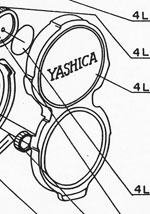
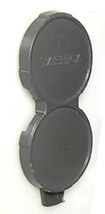
(Lens cap on right from larger web image)
Soft Plastic Push-on (Yashica E)
1964-65
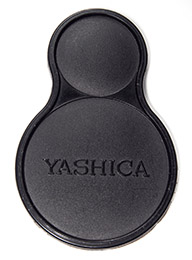
The only soft plastic lens cap for plain filter mounts, this has a much larger diameter lower part to cover the selenium cell.
Buying
Unlike ever-ready cases and boxes, lens caps are often considered essential items by both collectors and users. Whilst you may find something that fits and does the job, it would be nice to find something which is in character with your particular model, particularly if you are a collector. Having said that, from a user perspective, the plastic lens caps are easiest to use, least likely to fall off and are much less likely to mark lens bezels.
Previously, I provided a guide as to how frequently I felt that various types lens caps appear for sale. I have to say that by 2014, they are all hard to find and the best chance is to find a camera with one. Most likely to appear are for Bay 1 66 models, either the hinged cast metal type or one of soft plastic types, although the tabbed one is rarer. Least likely remain Pigeonflex, Yashima Flex and Yashica Flex B types. Also where there is a colour choice, anything but black or grey are also very rare.
For the practical user, Alternative Lens Caps explores some non-factory options.
Camera Ever-ready Cases
I love camera ever-ready cases because like the boxes in the following section, the early ones particularly hold many clues about camera development and how various models relate to each other. However, I am not very fond of ever-ready cases as a practical means of carrying cameras, or as the joke goes, never-ready cases. They are not very convenient when changing film and just getting them on and off causes wear. Often the old straps are weak and these should be replaced anyway if used for carrying the camera. They are not good for storing cameras in because leather absorbs moisture which is conducive to fungus. Having said that, I have a few - stored separately. If a camera comes with a case in any condition, it is well worth looking after because it can add value or even just make packing easier if selling. However, I would recommend against buying one for an existing camera with the intention of everyday use. There are better solutions available these days. Collecting, now that's a separate decision.
If looked after, they wear reasonably well but seem to scuff easily. Weak points are stitching, which seems to be affected by time and storage environment as well as the pulling apart of the case to fit and remove the camera, and the flap on the front near the three press studs where the front folds down. Little tears tend to develop here, particularly with the models with metal edge strips.
The earliest Yashica Flex models S and B brochure, the Yashicaflex A user manual and other documentation of that period suggests that early cameras were sold complete with cases. By the late 1950s and early 1960s, US catalogues indicate that most cases were extra cost accessories. This may have differed between markets, distributors and dealers as well. A 1962 Australian catalogue has prices listed including cases. The 1960 Olden Camera and Lens Company catalogue from the US has ever-ready cases listed separately for all models but for the Yashica 635, includes the “deluxe leather compartment” kit case. The 1961 Sears catalogue included cases in the Yashica 44A and 44LM prices. I have also seen evidence in at least one catalogue that suggests that even though cases were priced separately, there was no option to not include them in the purchase.
As with the cameras, there was evolution rather than revolution. Generally, there are limited styles but backs, or half cases, which include the sides have to be matched to the camera features e.g., knob or crank wind, exposure meter or not, red window or film counter, front sync or side sync, Yashica 635 35mm bits and very importantly with the Yashica LM, whether high set or low set accessory shoe. Fronts are more universal but can catch out the unwary. As far as I am aware, the metered knob wind models don't add any complications but the metered crank wind models do - see further below.
Some cases from the mid 1950s to perhaps early 1960s have special marks (e.g. <TK>) embossed in the bottom near the tripod socket hole. Details are here.
Case Straps
Cases are found with either neck straps or shorter carry straps. In reality, until the new style case with “Yashica” on the front and removable neck strap was introduced in 1965, the two ends of the strap were permanently attached to the rings on the ever ready cases. One end has a buckle through which the plain end is secured. That provides the carry strap length. A separate longer piece with buckle on one end was available for insertion between the two end pieces. Joined together, this provides the neck strap length. I assume that the extension was supplied at time of purchase.
Case Retaining Screw/ Tripod Adaptor
Except for later Yashica Mat-124G cases, all Yashima/Yashica TLR cases have holes in the bottom so that presumably the camera can be attached to a tripod without removing the case. The tripod would need a suitably long screw, or a screw in adaptor. Most 35 mm film camera cases have a captive screw in the base which both attaches the case to the camera and acts as an adaptor for the tripod screw. Early Yashima cases were supplied with the retainer/adaptor but because it was not captive, most have been lost with time. In terms of design, it is interesting to note that most, but not all, Rollei cases I have seen don't feature a hole in the bottom of the case. This case (also featured below) and screw belong to an early Yashima Kōgaku Seiki type Pigeonflex:
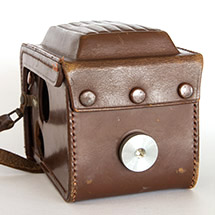
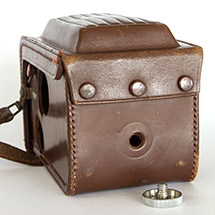
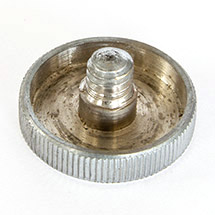
Without the locking tabs through the strap holder slots of later cases, the Pigeonflex cases probably benefited from the added security of the screw but it was not necessary for later cases. I have seen photos (mainly on Japanese auction sites) of the screws with most early models up to and including the Yashicaflex C and even a Yashicaflex B (new model) and contributer Sandu Baciu has a Yashica Mat-LM case with the screw but very few cases still have them. They also leave a tell-tale mark on the case as above. From my own experience, two out of two Pigeonflex and Yashica Flex model B cases have the marks as does the early Yashimaflex case shown below but not a Yashima Flex case, two model S with NKS-FB shutter and one early with Copal shutter cases have the marks but not another early example with Copal shutter, a model A-II with Y.S.K. shutter case has the mark but not the first late bodied A-I or early bodied AS-II cases but an earlyish Yashicaflex C case still has the mark. Neither of my two Yashica Mat-LM cases or later model cases have the marks. It is possible that either the screws were accessories with mid-1950s and later cases or that they were discarded and not used with some examples or that people used the screws from earlier cases on later cases.
As far as I can tell, the retaining screws found with any cameras earlier than the Yashica Mat-124G are much the same as the Pigeonflex type featured above.
As noted, some of the Yashica Mat-124G cases don't have the holes. I can definitely say that the earliest type with silver nameplate do and that the last type with synthetic case material, don't. I think that the second type cases with black nameplate but first type half case do and the third type cases, also with black nameplate, but second type half case without the strap lug retaining sliders don't (see Mat-124G cases at the end). The holes, where they exist, appear to be smaller in diameter than on previous cases and may hold a retaining screw captive if fitted. A number of cases have what looks like a black plastic knob with threaded shaft. Most that I have seen look like the examples below but there are also some that are different and it is not possible to know if they are original or not.
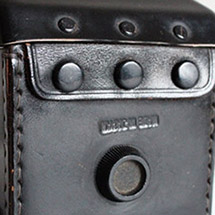
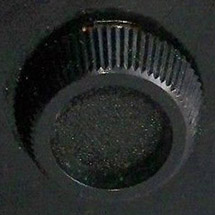
(Detail from larger web images)
Case Styles
1953
The early Yashima and Shinano Pigeonflex cases I have seen look very similar to each other. Cases for both Yashima and at least early Shinano made examples have “Pigeonflex” embossed in similar style across the front near the top edge and the top and front are in one piece. All later Yashima cases, starting with the Yashima Flex (but not the earliest found example - see below), have the top and front joined by two rivets allowing limited tilt movement. The case for the later Shinano Pigeonflex IB (and possibly the budget Pigeonflex I released at a similar time) also features the new style case with two piece front and top. Unlike the Yashima and earlier Shinano Pigeonflex cases, the name is now italicised. In general, any cases without provision for a side sync are definitely for Shinano, they probably also have a cut-out for an accessory shoe and both early and late types seem to have the Pigeon brand logo in a circle embossed in the centre of the ribbing on the front. I also think that the Shinano ones are only found with eleven vertical bars on front.
There are three Yashima Pigeonflex variations that I am aware of. The first type, found with five of the earlier Yashima Seiki versions of the Pigeonflex and also with five earlier Yashima Kōgaku Seiki type, has two concentric rectangles on the otherwise plain centre panel. This one belongs to the third earliest Yashima Seiki example in my database (only 26 cameras after the earliest):
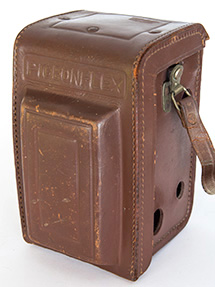
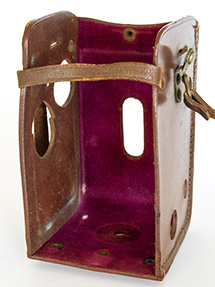
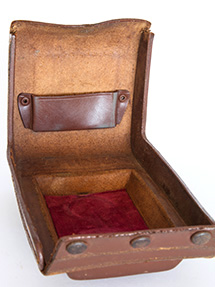
The second type appears to overlap the first. It is the most common and has six bars, or ridges, across the front. This one came with one of the earliest Yashima Kōgaku Seiki type Pigeonflexes in my database:
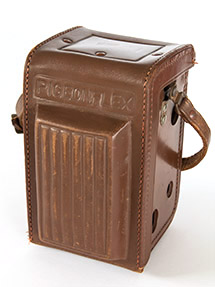
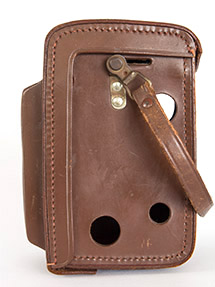
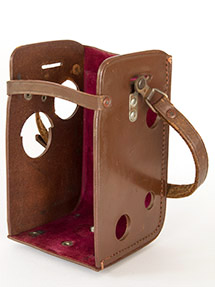
The last type has eleven bars like the Shinano examples. Also like the Shinano examples, there are no rivets in the top, nor is there presumably an internal panel, as shown above for the earlier types (I'm not sure whether it is intended for reinforcement and/or shape or as a pocket for something). As the Shinano Pigeonflex IA appears to be closely related to the Yashima Flex, it's no surprise that its case is very similar to the last Yashima Pigeonflex type.
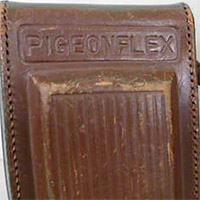 (Last Yashima Pigeonflex case detail from larger web image)
(Last Yashima Pigeonflex case detail from larger web image)
Other makers had similar designs with one piece fronts which makes me think that it was a Rollei copy but the only similar ones I have been able to find are for the Rollei Magic from the early 1960s and the soft case for the late Rolleiflex 4x4 and some very early cases from 1928 to 1932 period which had a similar one piece front and top but without the ribbed or embossed styling. Perhaps Japanese designers combined the simplicity of the original Rollei cases with the style of the two piece designs of the 1940s and early 1950s? Small makers like Yashima was then would have bought cases in to a standard design which probably also accounts for the similarity of many of the early cases from Japanese camera makers.
The very first “Yashimaflex” cases were still very Pigeonflex influenced except that the top and bottom of the protuberance over the lens set is curved, unlike Pigeonflex and other cases, and also unique is the new super-sized logo embossed on the front:
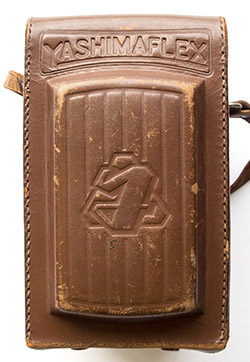
The sides are still flat slabs like the Pigeonflex type but the retaining strap is gone and the sliding metal tabs through the strap holder slots of later cases are already in place. The style of lettering on the case is Pigeonflex-like to match the single word “Yashimaflex” on the first type nameplate. Note that that the front is connected to the back with only two press studs - Pigeonflexes and all other cases use three press studs (there is also a typical case retaining screw/ tripod adaptor, not shown):
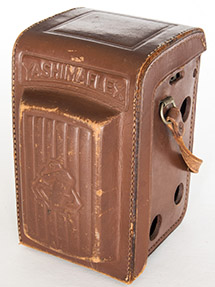
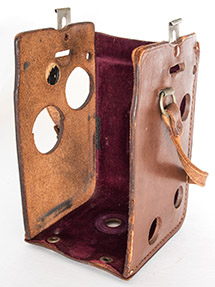
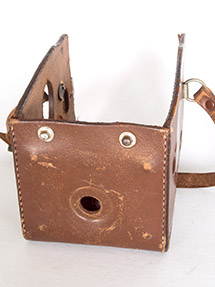
The featured case belonged to the very earliest type Yashimaflex found so far which is owned by Tom Heckhaus and is featured elsewhere on the site. The second earliest Yashimaflex has the same case. A similar case has also been found with camera 357xx which although very early, is already the more commonly found type with two word “Yashima Flex” nameplate and focusing hood with sports finder and logo. The only discernible difference with this case is a cut-out for the accessory shoe.
The Yashima Flex case, left below, is representative of the next style which is certainly very much 1940's/50's Rolleicord influenced and also very similar to the same vintage cases from other Japanese makers. Except for the ribbing on the front, the metal logo and the colour, the front design carried through to the Yashica A and remained until its demise in 1968 or 1969. The half case on the right would have had a front the same as the case on the left. It is already starting to look like later cases but note that on those, the stepped front edge design is one piece moulded, here it is two piece sewn:
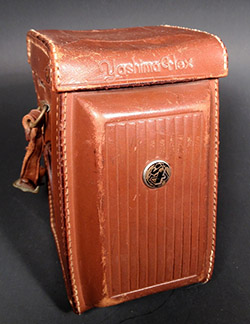
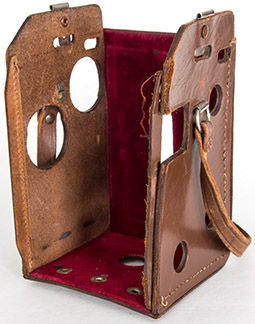
(Left image courtesy of Sandu Baciu)
The half case below belongs to Yashica Flex model B, serial number 47259, at the 1/3 mark of production and still with the lenses marked “Tomioka Tri-Lausar”. The top front corners are curved, rather than the two separate angles of the Yashima Flex case above or the 45 degree angle of the following cases, and the interior liner is a gold colour instead of the red of most other models.
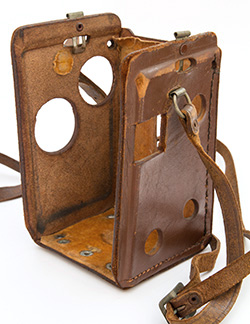
The cases now have three significant improvements over the original Pigeonflex case:
- The top and front are separated to allow some movement.
- The sides are sculpted instead of flat slabs so sit more neatly against both the camera sides and the front of the case and also provide greater rigidity.
- The Pigeonflex case has a strap which clips across the bottom of the nameplate to retain the camera in place. The Yashima Flex cases and all subsequent 66 cases, except for the last Mat-124G types, have metal tabs which slide vertically up and down to lock the camera in place through the strap holder slots (both systems are also found with Rolleicord cases).
This is a later Yashica Flex B case and features a red liner with the top front corners of the half case now angled at 45 degrees instead of curved:
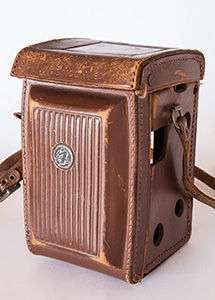
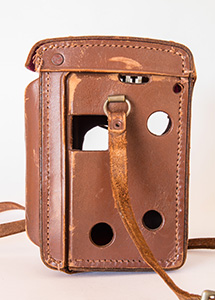
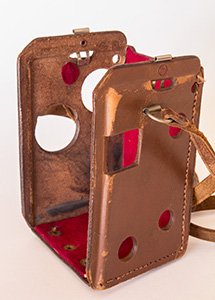
The earlier round corners and the gold liner of the first Yashica Flex model B case are also repeated on the cases of the first Yashica Flex model S examples with NKS-FB shutter (the one below belongs to camera 29563) until at least camera 32xxx, at about the 2/3 mark of production of the NKS-FB version. This is another very strong indicator that the Model B and early Model S co-existed rather than followed each other:
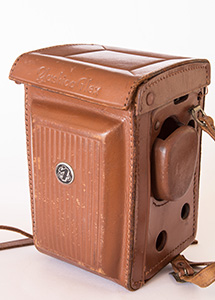
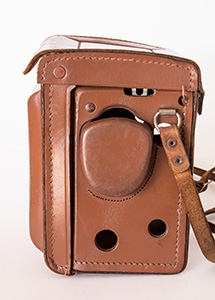
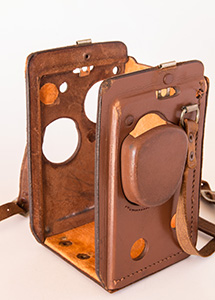
A case for a slightly later camera, 31954, is the first with angled corners and red liner but still has the separate stitched and riveted piece over the meter housing and rear-set strap rings. Note that a lower rivet has also been added:
.jpg)
The later case below is from an early Yashicaflex S just after the change to Copal shutter but still with early body type. The case for earlier camera 33xxx with NKS-FB shutter appears to be the same. These also have the new angled corners and red liner but the meter cover is now integral to the side piece enabling the strap rings to be moved forward over the meter housing for better balance:
 019.jpg)
 021.jpg)
 027.jpg)
The next Yashicaflex S cases have the inside corners reinforced with a 45 degree angled metal protector, as seen below, but on the last of the Yashicaflex S cases, the protector was curved as on the Yashica Mat-LM case a little further down. The metal corner reinforcement also appeared on Yashicaflex A series cases (probably from around the change from cable to push button shutter release on the A series) at about the same time, coinciding with the first appearance of the Yashicaflex C in 1955. The metal reinforced corners generally appeared from then on but they are missing on the Yashica 44A and from all mid-1960s cases onward. This Yashicaflex S case is for a Copal shutter type with new body and flash sync connector on the front. Note that the strap rings have again migrated towards the rear to make room for the hole just above the meter housing. This is to accommodate the strap lug on the new long type strap holders. Also note that the “Yashica Flex” script of the earlier cases matches the model S nameplate. On this case it is still in a two word form (the “f” of “Yashica flex” is now lower case) but the script matches the style of the A series cameras. On the last version, the transformation is complete and the name is the single word form “Yashicaflex” in the A series style.
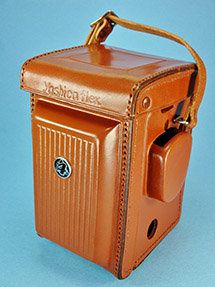
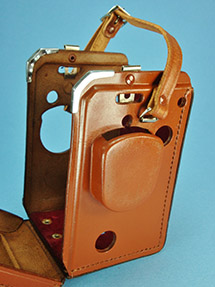 (Images courtesy of Chris Whelan)
(Images courtesy of Chris Whelan)
The Yashicaflex AS-II cases are the same as the later Yashicaflex model S cases, starting with the type to suit the old bodied model S with the new Copal shutter already. At this point, the name is still in the two word form Yashica Flex model S nameplate script but changes in line with the model S changes noted above.
The budget Yashicaflex A-I, A-II and later A2 models (and the later more up-market new Yashicaflex AS - see further down) have the same style cases as the earlier types except that the metal logo is replaced by the word “Yashica” inside an oval embossed into the leather (that arrangement is even more Rolleicord-like). However, on very late A-I and A-II cases and on the A2 (and AS), there is no rectangular flat area and the ribbing comes to the edge of the oval.


(Right detail from larger web image)
The case below belongs to an early Yashicaflex A-II with early body and Y.S.K. shutter, probably from the end of 1954:
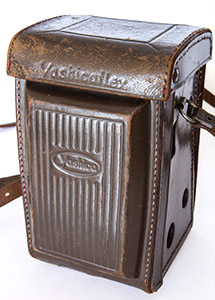
Below is a case that belongs to the first Yashicaflex A-I in my database with new style body (early 1955). The A-I and A-II, including for the Y.S.K. shutter types, were the same except for provision for rear-set strap holders on early cases and of course, red window or no red window (the colours of the two cases shown are very similar in real life - different natural lighting at different times):
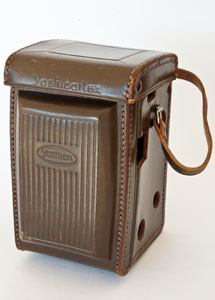
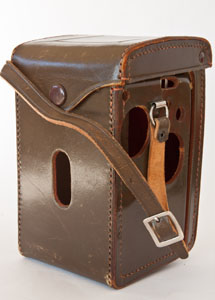
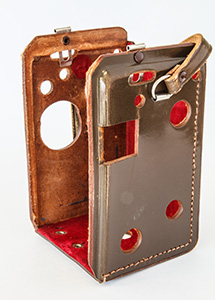
All the earlier Yashicaflex A-I and A-II cases with the rectangle (the majority of examples) I have found and all examples of the later AS (new model) cases have a more chocolate brown finish than other models. However, I do have a front attached to a very early Yashicaflex AS-II case which has both the rectangular surround and is more orange, same as the back. If it is original to that case, it is different to the other AS-II cases (circular metal logos), including the very oldest found (also still with its two word Yashica Flex model S script). Its origin remains unclear to me, perhaps Yashima was going to use an A series style front attached to the typical Yashica Flex model S half case but then decided it was cheaper to go with the one style case for both metered models than separate dye jobs for the A series front parts. Or maybe there are early A-I and A-II orange brown cases that I haven't found yet:
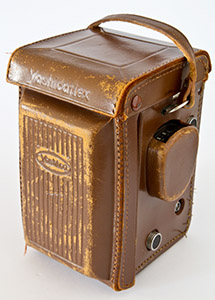
Although the early cases look very similar, there is a subtle difference in the number of bars or ridges in the front ribbing, even amongst the same models (note, these only reflect what I have found):
- Pigeonflex - 6 bars. Yashima made.
- Pigeonflex - 11 bars, side sync, no accessory shoe cut-out. Yashima made
- Pigeonflex - 11 bars, no side sync provision but accessory shoe cut-out and probably Pigeon logo embossed. Shinano made.
- Yashimaflex - 6 bars. First type with one piece front and top and Pigeonflex-like name.
- Yashima Flex - 12 bars found on two examples but above example has 10 bars.
- Yashica Flex B - 12 bars on the example above from the middle of production, 10 bars on a very late example.
- Yashica Flex S - 12 bars. Very early type camera with NKS-FB shutter, Tri-Lausar lenses and maker name on nameplate.
- Yashica Flex S - 10 bars. Above case for my early bodied example with Copal shutter.
- Yashicaflex S - 11 bars. Later examples.
- Yashicaflex AS-II - 11 bars.
- Yashicaflex A-I & A-II - mainly 12 bars including my early Y.S.K. shutter example but my brown A-I case above has 13 as does a similar vintage A-II case owned by contributor Chris Whelan.
- Yashicaflex A2 - 11 bars.
- Yashicaflex AS (new model) - 11 bars.
Is the variation from 10 to 13 bars based on design refinements, random manufacturing variation or different suppliers?
1955
For the Rookie and early Yashica A, the only change to the Yashicaflex A-I style was the removal of the embossed vertical ribbing on the front in favour of a smooth finish. I have photos of both early and late MolfoReflex cases and both are like the Rookie and Yashica A (rather than the Yashicaflex A-I that the camera is based on) but without name or model identification. Putting this around the correct way, it seems that the plain MolfoReflex case set the style for the Yashica A and Rookie and with oval metal logo, the style for the Yashicaflex C, Yashica C and LM:
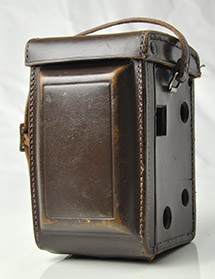 (Image
courtesy of Göran Årelind)
(Image
courtesy of Göran Årelind)
This is an early side sync Yashicaflex C case:
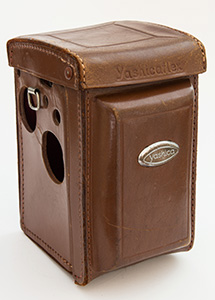
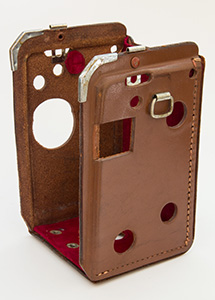
I have seen both orangey brown and brown cases (the above one seems in-between!). I'm not sure if one is earlier or both were available at the same time (most early cases seem to look more like the one above so maybe the other two colours are new?). Both examples below belong to later cameras with front flash sync sockets (cases for the earliest Bay 1 lens hoods, which appeared at about the same time, are found in both colours):
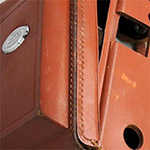
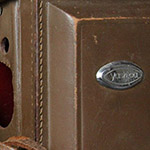 (Detail from larger web images)
(Detail from larger web images)
Yashica Rookie case shown below. It is the same as the early Yashica A case except of course for the name across the front of the top and the cut-out for the different red window arrangements:
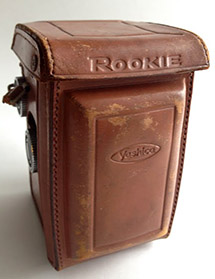 (Image courtesy of Sandu Baciu)
(Image courtesy of Sandu Baciu)
The cases for the Yashica C and Yashica LM (introduced in late 1956) look the same as for the Yashicaflex C (note that the LM circular meter cover is not visible in this wide angle shot). Except for the glossier finish, lack of ribbing and the oval logo, still much the same as the Yashima Flex case:
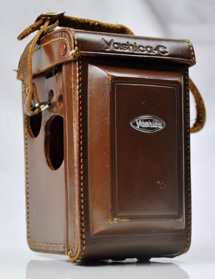
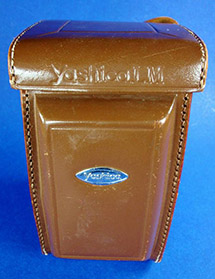
(Left image courtesy of Göran Årelind, right image courtesy of Chris Whelan)
1957
Then, except for the budget Yashica A (and the yet to be released new Yashicaflex AS), came a change in style to the front part ushered in by the new Yashica-Mat with 75 mm Lumaxar lenses in April 1957. The back remained essentially the same. The leather is glossier and less flexible than earlier cases, no doubt aided by the metal reinforcing and a fully moulded top and front piece in place of moulded and stitched. Unlike later versions, “Yashica-Mat” is embossed in the leather of the front panel under a large metal shield shaped logo and the colour is more noticeably orange in some photos, like this one:
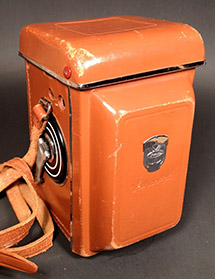
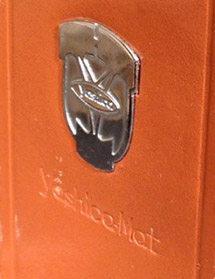
(Images courtesy of Sandu Baciu)
Later in 1957, near, or at the time that the Yashica-Mat lenses were upgraded to the Lumaxar 80 version, a new logo was introduced and the name was changed to metallic letters on the front edge of the top:
 (Image courtesy of Callum Colville)
(Image courtesy of Callum Colville)
The very similar one below is from a Yashica Mat-LM of 1960 vintage (note the “LM” embossed in the centre panel on top, I believe that the only other model to feature this type of model distinction is the 44LM). The Yashica-Mat and Yashica Mat-LM cases are fairly typical of cases from the Yashicaflex A (new model) and B (new model) of 1957 through to the mid-1960s. The front logo shown is unique to the early Yashica-Mat and Yashica Mat-LM and both are usually found in the same brown colour. This style Yashica-Mat case didn't change until 1964 and of course, the Yashica Mat-LM came to an end then. Yashicaflex cases of this type, including ones for the Yashica 635 (see “66 Models”), had “Yashicaflex” across the front (in place of “Yashica-Mat” on this one) and a similar front logo as the Yashicaflex C oval (like the Yashica B cases further below).
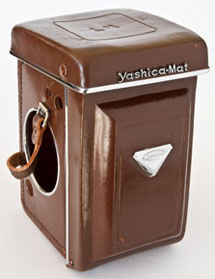
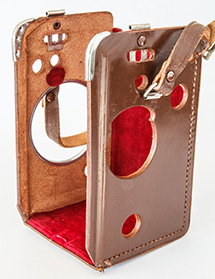
Note: Whilst crank wind cases of a similar era look identical, there is a subtle difference. On metered models starting from the Yashica Mat-LM forward and up to and including the Yashica Mat-124, the top is slightly more squared off and protruding at the front to make room for the meter assembly. Models with CdS cells have a cut-away around this on the front panel top edge (not normally visible). Therefore, cases from models with meters will fit the Yashica-Mat but are more bulbous than necessary. Yashica-Mat cases can probably be squeezed onto metered models, my Yashica 24 came with one, but its not ideal for camera or the case.
The Yashicaflex AS (new model) with the Citizen shutter and control wheels is an unusual camera. Clearly from trim items as well as various sources, it was released after the Yashica C and LM and after the Yashica-Mat. Its case, however, is a throwback to the Yashicaflex A-II with ribbing returning to the front and embossed oval logo instead of metal. Its replacement, the Yashicaflex B (new model), received the new style case. The Yashicaflex A2, released slightly earlier at about the time of the Yashica C and LM, also returned to what looks like a Yashicaflex A-I case. (Both cameras have been found with items indicating that they were marketed as “Yashica” models in Japan whilst retaining their Yashicaflex identity and heritage, see here.)
The brown case below left is for the earliest Yashica B in my database, a black example with the earlier stylised logo. It is a little more chocolate brown than later cases and except for name, it is also identical to the Yashicaflex A (new model) and Yashicaflex B (new model) cases. The grey case in the middle is for an earlyish example with grey leatherette. The brown case on the right is for a slightly later black Yashica B and has the same logo as the Yashica D below but there were also grey cases for grey cameras with this logo:
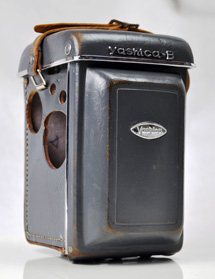
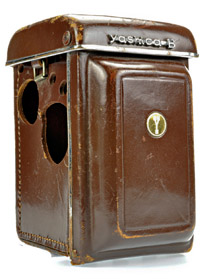
(Left image courtesy of Sumanta Chandra, centre image courtesy of Göran Årelind, right image courtesy of Tom Heckhaus)
From first production of the Yashica D until February 1959, the majority of production cameras featured coloured leather and metalwork with a new narrow “Y” on gold background logo for the domestic Japanese market. The very small number of export cameras (signified by the ® mark) still featured the traditional black leatherette and metalwork with the earlier stylised focusing hood logo. Below left is the brown Yashica D case, with oval logo still, used for black export cameras until sometime in February 1959 when export cameras also became coloured and became the majority of production, on the right is a grey case with the circular gold background logo, similar to the focusing hood one, supplied with early coloured Yashica Ds and all Yashica Ds until production of coloured Yashica Ds ended in April 1960:

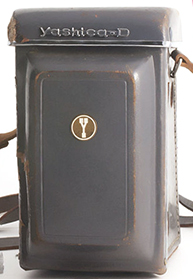
(Detail from larger web images)
The Yashica D case below left would have had the same gold background logo as the previous example. It's significance is that it belongs to the one black D with gold hood logo found amongst the later coloured examples. The case below right is the standard brown leather case introduced with the return of the black Yashica Ds in April 1960 until a new logo appeared in July 1964:
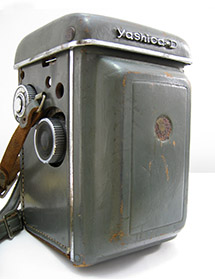
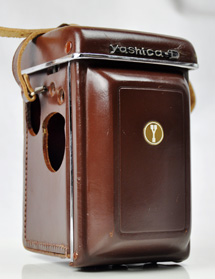
(Left image courtesy of Dillon Ang, right image courtesy of Göran Årelind)
Grey cases with the narrow “Y” on gold background logo also appeared for coloured Yashica As but their style remained the earlier type with stitched top and front panels. The top is embossed “Yashica A” but is the same for both Yashica As and Yashica A IIIs. The later brown cases for the black Yashica A cameras continued with this style, this one from 1964:
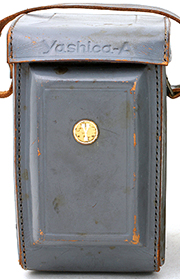
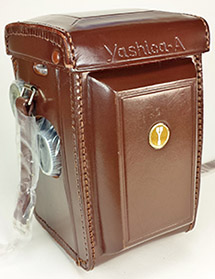
(Web image on left, right image courtesy of Chris Whelan)
It was not until about 1964 before the Yashica 635 case, still with the inexplicable “Yashicaflex” across the front (as noted earlier), changed from the oval to the narrow “Y” logo but this was the new one with the white enamelled background (see further below in “1964”):
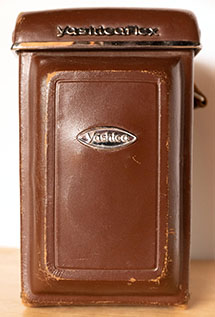 (Image courtesy of Gordon Brown)
(Image courtesy of Gordon Brown)
There was also a unique rectangular leather Yashica 635 kit case which is described separately in Yashica 635 Compartment Case.
The Yashica Auto case only differs from the contemporary Yashica-Mat case in terms of colour, name and logo. It was grey for both black and grey leatherette cameras:
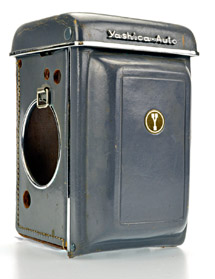 (Image courtesy of Tom Heckhaus)
(Image courtesy of Tom Heckhaus)
The two features (apart from size) that divide the 44 series cases from their 66 cousins is that there are no sliding tabs to secure the case to the slots of the camera strap holders (there are no slots on 44 models) and there are no separate case neck straps - the camera's own quick release strap is re-attached after fitting the case.
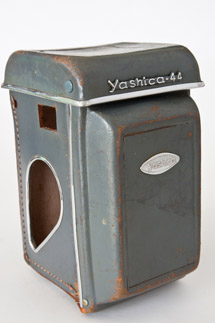
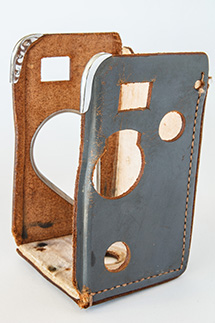
This case belongs to an early Yashica 44 and except for the logo, is very similar to the larger Yashica-Mat and Yashica Auto cases and like the Yashica B in terms of logo. Most Yashica 44 cases are grey like above but I have found five black cases; two with Lavender cameras, one with a Rose Brown camera, one with a Burgundy camera (it should be noted that the other coloured Yashica 44s in my database did not have cases) and one with a Silver Gray camera. The case below belongs to the Burgundy example:
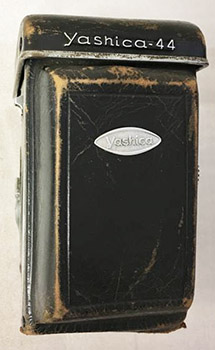 (Detail from larger web image)
(Detail from larger web image)
There doesn't appear to be any evidence of re-colouring.
The cheaper Yashica 44A received a miniature version of the Yashica A case with stitched panels on the top and front but with the name in metallic letters like above. Also, it has no metal reinforcement on front or back. Here is a rather sad early grey example:
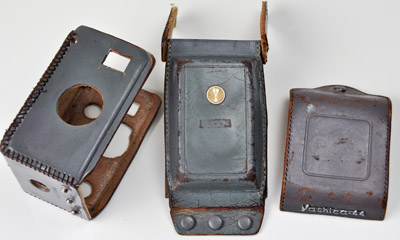 (Image
courtesy of Göran Årelind)
(Image
courtesy of Göran Årelind)
I was in two minds about using this image (and I'm not sure that Göran wanted me to) but it does illustrate what the end result will be once the stitching shows signs of weakness. Note that the back has been reassembled with hand stitching. Below is a later brown example that belongs to a grey 44A:
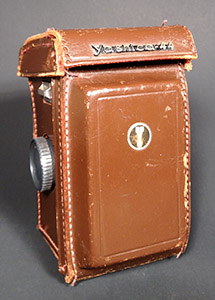 (Image courtesy of Sandu Baciu)
(Image courtesy of Sandu Baciu)
The Yashica 44LM surprisingly received a version of the Yashica 44A style case but with simplified front piece, probably caused by the wider profile of the camera front with control wheels. However, unlike the 44A, case, it does normally have metal reinforcing strips along the front panel edges and the top front corners of the back section. The closest 66 case style-wise belongs to the later Yashica E. The example below came with a brown camera from very early Yashica 44LM production. It is missing the side reinforcing pieces from the front panel - whether they have been removed or weren't there on early examples, I don't know but all other examples I have seen have them.
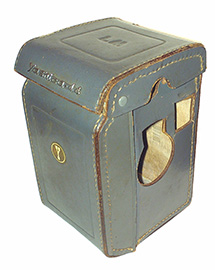
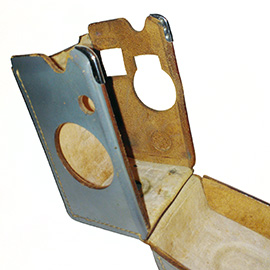
(Images courtesy of Bill Pruitt)
Both Yashica 44A and 44LM cases seem to have at first come in grey only and then changed to brown later when, ironically, the grey camera versions became the only colour available, although the earliest grey examples did still have grey cases. Except for the most recent examples noted below, all of the the 44A and 44LM cases seem to have the narrow “Y” on gold background logo like the Yashica D above.
1964
Very late 44LM cases (nine of the last eleven cameras with cases in my database starting with camera FL 4010xxx) and 44A cases (three last cameras with cases, FA 5040xxx to FA 5060xxx - so far, there are no 44A cameras with “FA 4xxxxxx” serial numbers), the first Yashica Mat-EM cases and probably all cases of other cameras in production in 1964 received a new narrow “Y” logo reminiscent of the new Yashica Mat-EM hood logo. Instead of the old white on gold flat logo, the new logo is 3 dimensional with raised “Y” and circular border in shiny gold metal on a creamy white enamel background. The examples below belong to a Yashica 635, still with “Yashicaflex” across the top, a plain Yashica-Mat, a Yashica A and a Yashica 44A:
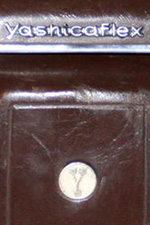
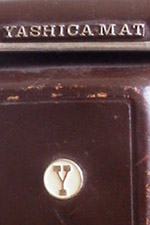
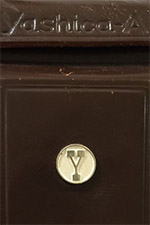
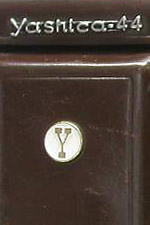 (Detail from larger web images)
(Detail from larger web images)
Below is a Yashica D version. I thought that all 66 cases between the Pigeonflex and the third type Yashica Mat-124G cases utilised sliding metal tabs through the strap holder slots to retain the camera but this one features a strap across the nameplate like the original Pigeonflex type (the camera itself is an earlier 1958 version):
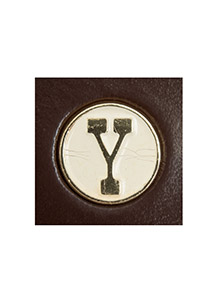
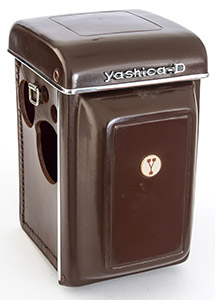
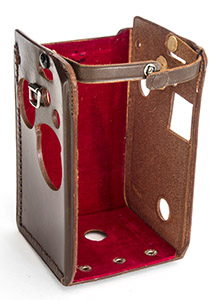
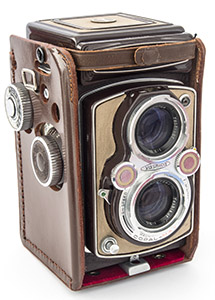
Because cases are mainly displayed in the closed position, I have no idea whether this style was common at this time, or it has something to do with the Japanese domestic market (the camera and case were sold at auction in Japan). Contributor Chris Whelan has acquired a beautiful Yashica D set from the UK with January 1965 serial number. The ever-ready case has the same enamel logo but is otherwise typical with the sliding locking tabs.
One other camera case that I should mention is for the Yashica E which was released in 1964. The case was designed to meet the particular needs of that rather unusual camera, i.e., a wide front panel to cover the selenium cell and a rectangular window in the back for access to the flash exposure guide table. In terms of style, it looks somewhat like a fat budget brown Yashica A case with the narrow “Y” logo embossed instead of the circular metal badge but with metal reinforcing to the edges of the front panel. In fact it very closely resembles the style of the smaller Yashica 44LM case:
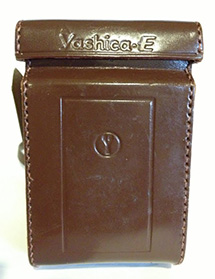 (Image courtesy of Sand Baciu)
(Image courtesy of Sand Baciu)
1965
The narrow “Y” on enamel background didn't last long. From about 1965, other than for the Yashica A and the new Yashica 24 (see below), cases for all 66 models still in production, including both the Yashica 635 ever-ready and compartment cases, received the new style logo as displayed on the brown Yashica-Mat case below for a camera with the new wide “Y” focusing hood logo (note the return to the sliding tabs):
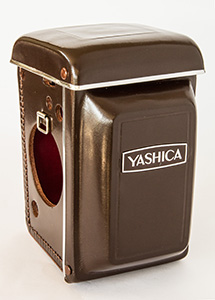
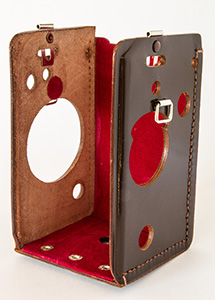
Note that the model in metallic letters, including “Yashicaflex” on the 635 case, is no longer displayed. The metal reinforcing on the front corners of the back half and around the large hole for the crank was also deleted (as it already was on the front corners of the Yashica D case above). The case strap changed from the leather convertible two/three piece carry/neck strap with permanently affixed end pieces to a single piece plastic removable type (at some point, probably in the mid-1967 to 1968 period, this style case changed to black).
Perhaps at about the same time or just a little earlier, the Yashica A and the very last Yashica 44LMs (last two of three with cases in my database) as well as the new Yashica 24 received a new logo too. This is a wide “Y” in bright gold on a white enamel background representing the new style focusing hood logo and is similar in style to the late narrow “Y” examples introduced in 1964. There were no other changes to the Yashica A case until its demise in 1968. The example below left belongs to the Yashica A with highest serial number in my database, detail from 44LM case on right:
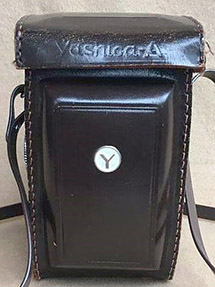
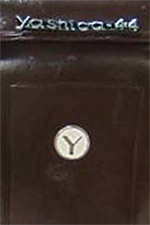
(Left image courtesy of Derek Horton, detail from larger web image on right)
Typical Yashica 24 cases from late 1965 are black and have a metallic “Yashica” badge on the front of the top and the new gold wide “Y” logo on a circular white background in the middle of the front (looks somewhat silver in this photo but gold in most others). I'm not sure whether Yashica was after a unique look for its new premium model, or it was designed before the above new style was released. No other case looks like this.


(Detail from larger web images)
However, I was surprised to find that its not the first version. The one below was found with a 1962 Yashica-Mat in Sweden. Its Yashica 24 pedigree is confirmed by the cut-out inside to fit the circular window of the models fitted with CdS meters and the cut-out below the focussing knob for the unique to Yashica 24 meter switch:
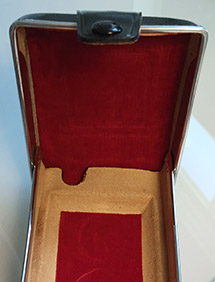
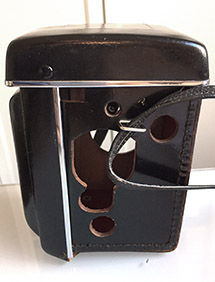
(Images courtesy of Adam Löf)
Not only does it feature the earlier narrow “Y” logo, the nameplate on top reverses the colours. The first Yashica 24s in my database were made in October 1965 and the earliest examples found with a case are from November 1965 and these are already of the later wide “Y” type. So a life of one month or less? I have to wonder whether it was ever officially released as the hood logo on the Yashica 24 was already the wide “Y” from the beginning. The 1962 Yashica-Mat (still in beautiful condition like the case) was bought new (that could still mean older stock) from a dealer in Stockholm, by correspondent Adam Löf's father. How it ended up with this obviously rare Yashica 24 case is a mystery.
In the second half of 1966, the Yashica 24 case changed to a black version of the brown Yashica-Mat case above. Both of the Yashica 24 case types have a cut-out for the accessory shoe common to it and later crank wind models plus a unique one for the meter switch. As noted earlier for crank wind metered models, the top is more squared off and juts further forwards than the Yashica-Mat case too. The Yashica 12 case appears to be the same as the later 24 case (except that there is no cut-out for the meter switch).
I have a Yashica 635 from probably September 1967 with a case which is still brown:
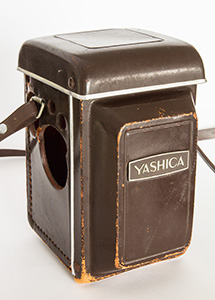
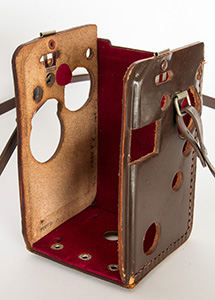
1968
Below is a Yashica-Mat case from about 1968 by which stage all cases, apart from the Yashica A, were black (with the exception of the Yashica A, cases of other models still in production had the same style case front parts). Note the larger cut-away for the crank than earlier cases. This makes fitting and removing the case a little easier. The very similar Yashica Mat-124 case had a cut-out on the crank side for the 12/24 reminder window and one on the focus side for the accessory shoe plus the usual more squared off and forward jutting top piece to accommodate the meter assembly.
1970
The final case style, shape-wise at least, was introduced with the Yashica Mat-124G for that model only. The front snout was simplified with a smooth taper from the front panel back to the sides. This required the front of the top panel to be cut away with the overall appearance being more squared off and angular. However, there were some detail variations with this as well (third variation of four shown):



Initially, the finish was shiny and the metallic logo was silver with the letters and surround in recessed black instead of raised lettering (Nameplate 1 further below). The first type case still has case strap lugs and sliding metal tabs through the strap holders to secure the case to the camera (similar to the black Yashica-Mat case above) - note the rubber piece that sits below the accessory shoe cut-away (not there on Mat-124 and earlier cases):
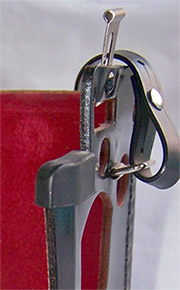 (Detail from larger web image)
(Detail from larger web image)
The second variation received a new metallic logo with raised silver letters in a black rectangular background (Nameplate 2) but retained the back half case with strap lugs and locking tabs. To me, the finish appears to be more textured. The third variation still has Nameplate 2 on the front but it received a new half case without the strap lugs and locking tabs as in the first example above. In their place are leather retaining straps which clip over the camera neck-strap now used for carrying the camera/case combo. Also, whilst the first style half case has a taper to the front edge of the sides to replace the earlier stepped design first introduced on the Yashima Flex case, on the later types, the sides are completely slab-like (see first example above), somewhat similar to the first Pigeonflex. I also think that it was at this point that the hole in the bottom of the case for the retainer/tripod adaptor was deleted (not there on fourth and at least some third variation cases). Further details are at Case Retaining Screw/ Tripod Adaptor. The fourth and final variation was a change to some type of matt synthetic textured material and the the logo was simplified to shiny raised letters on a plain black background recessed into the case (Nameplate 3).
 Nameplate 1, from 1970
Nameplate 1, from 1970
 Nameplate 2, from December 1976
Nameplate 2, from December 1976
 Nameplate 3, from around 1983
Nameplate 3, from around 1983
(Images 1 & 3, detail from larger web images)
The snout on the first three variations is constructed of a pink plastic overlaid with a very thin veneer of leatherette of some type. The inside of the snout on the fourth variation is a dark synthetic material which may not require a surface veneer. Due to the use of synthetic materials on all variations, the integral leather “hinge” of previous cases which connected the front to the half case is now a separate piece riveted to the bottom of the front piece. The side pieces of all half cases are of a thicker, more flexible fibrous material than the snout and have a thin surface veneer, presumably not of leather. The bottom/back part is thinner but I am not sure of the material. Final fourth case variation shown below.
 (Detail from larger web image)
(Detail from larger web image)
Yashica 635 Compartment Case
In addition to the availability of an ever-ready case, there was also a rectangular leather “compartment case” unique to the Yashica 635 model. In place of the usual information about how to remove the ever-ready case of other models, this same picture appeared in the first three of four 635 user manuals. In the last manual, featuring Yashinon lenses (1970), the instructions reverted to removing the ever-ready case.

An early ad, probably from 1958 and also 1967 and 1968 brochures state that the compartment case is included whereas with other models, the price is given as “plus case” (meaning ever-ready case). A 1966 US brochure states that the compartment case is included but that an ever-ready case is available at extra cost. UK importer Photax brochures don't refer to compartment cases but as with other models, mention that an ever-ready case is available at extra cost. Different markets and/or time periods may have had different options. In my experience, I have never seen a 635 with both a compartment case and ever-ready case, only one or the other. My assumption is that like some of the ads suggest, the compartment case was the standard offering and if desired, the ever-ready case could be purchased separately. That may have changed towards the end. However, I have undoubtedly seen more Yashica 635s for sale with ever-ready cases than compartment cases so how the cases were offered is still somewhat murky.
I have seen both chocolate and mid-brown leather colours. The early cases feature “Yashica 635” in metallic letters (not the “Yashicaflex” found on ever-ready cases until at least 1964). The interior is divided into three compartments; the 35 mm kit in its case at one end, the camera lengthwise on its back and another small compartment at the other end for film and filters. The liner in the early cases is a light creamy tan colour.
The case in the 635 user manuals is shown fastened by a press stud. This seems to be the first type fastener and was used only briefly. I have only seen two examples in the wild:
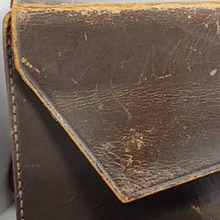
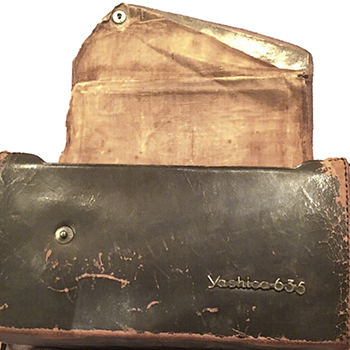
(Detail from larger web images)
The slightly later 1958 case below belongs to contributor Chris Whelan:
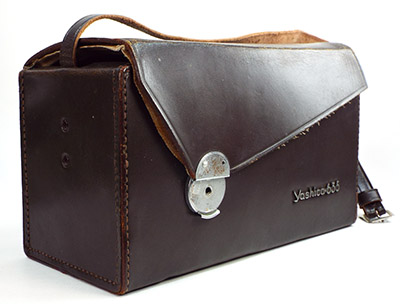
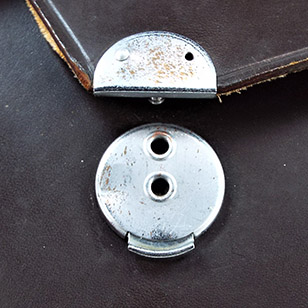
(Images courtesy of Chris Whelan)
This example has a two position latch with the holes about 10 mm apart. Chris suggests that might be an expansion facility if the camera is inserted in its ever-ready case. The photo on the left is with his camera in its ever-ready case inside (the camera came with a modified Yashica C case, not the optional 635 version). This is the only example I have seen so it didn't last long. Following cases have a similar latch but with only a single, central hole.
Later cases are the same design with updated design details. The latch changed to a more secure tongue and staple type. They now had a red liner and the “Yashica 635” letters were replaced with the plain “Yashica” badge which appeared on ever-ready cases in 1965:
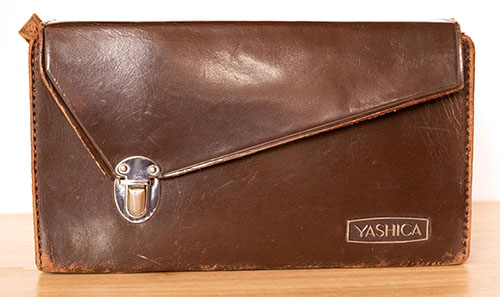 (Image courtesy of Gordon Brown)
(Image courtesy of Gordon Brown)
Boxes
Boxes have value to collectors and therefore should be looked after. They add value to a camera and also like ever-ready cases, make it easier to pack safely if selling. I like boxes because they display the character of the times and the graphics styles reflect Yashima's/ Yashica's marketing vision for each of the models. They originally seemed to be designed for ongoing storage of the cameras and were clearly patterned on the Franke & Heidecke items for their Rollei models. They are also very similar to boxes provided by other Japanese makers, only the graphics and quality of finishes varying. No doubt that these items were also bought in.
Outer or Distribution Box
The storage box, or “presentation box” as it is called by some, may have been packed inside another brown cardboard box for distribution and sale - these have rarely survived. The earliest I have seen is a “Yashicaflex Model A” box for a 1955 new body type and two for early Yashicaflex C cameras from 1955 and the latest for three 1964 Yashica Mat-EMs with their “modern” boxes already and a 1965 Yashica D with one of the new “66” boxes - by those examples, the outside box had simply become a sleeve. They all have a space for body serial number, “B”, and taking lens number, “L”. Below is the earliest Yashicaflex C outer box, belonging to camera 511xxx, and a 1960 Yashica A outer box. An earlier Yashica A and Rookie pair, Yashica-Mat, Yashica Auto, Yashica Mat-LM and Mat-EM examples are a little further down in the next sections:
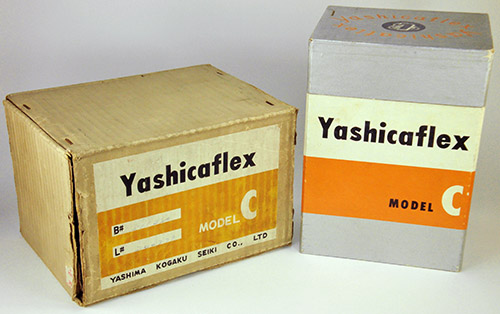
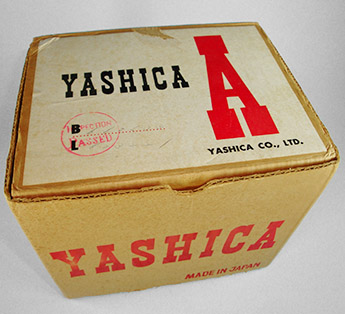
(Images courtesy of Chris Whelan)
Inner Presentation or Storage Box
The earliest storage boxes that have been found are right from the beginning. All of them appear to be very similar until the early 1960s when new simpler, lighter and, no doubt, cheaper versions began to be introduced. These are more just product packaging. The 1950s boxes have lift-off lids, paper lining and similar physical style, size and substantial build. The 44 series boxes are similar, just smaller. This is a pair of Yashica A boxes, the left from 1957 and the second from 1964. The 1964 box is the first of several variations, the later ones losing the distinctive graphics and colours for each model in favour of a generic style and colour scheme with a label identifying the model (except for the Yashica Mat-124G with its own unique box):
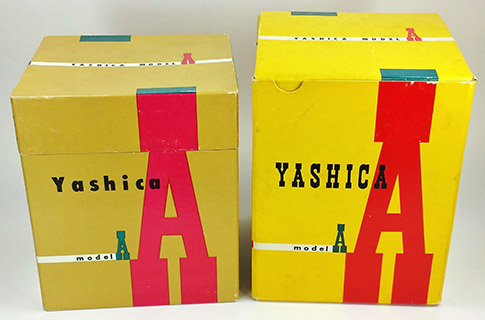 (Image courtesy of Chris Whelan)
(Image courtesy of Chris Whelan)
Chris has measured the 1957 box to weigh 352 grams and the 1964 box to weigh 155 grams. That tells the whole story really. The marginal increase in height was probably due to using polystyrene foam top and bottom packing pieces instead of the earlier folded cardboard inserts.
Inner Presentation or Storage Box 1950s to Early 1960s
The Pigeonflex examples that belong to the two boxes below (lid missing on right one) are both Yashima made. The dark blue base with a white reptilian pattern above and gold text is the same style as I have seen on a Pigeon 35 model J box (the model J was advertised together with the Yashima Pigeonflex) so I assume that, as expected, the graphic design is marketing company Endō's rather than Yashima's. A Pigeonflex “catalog” (as translated), or some sort of flyer, or more likely a shop display card, with the left box and its camera has Endō's address on the back and a picture of a Yashima made Pigeonflex on the front:
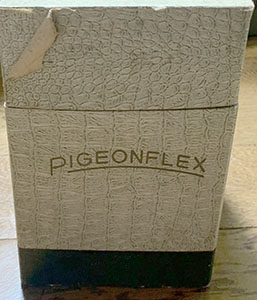
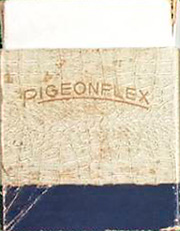
(Detail from larger web images)
The Yashima Flex box below is in surprisingly nice condition for its 65+ year age:
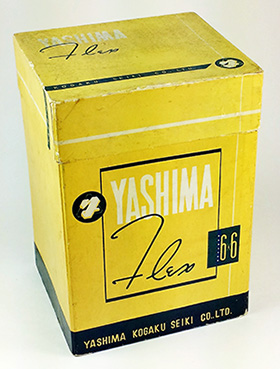
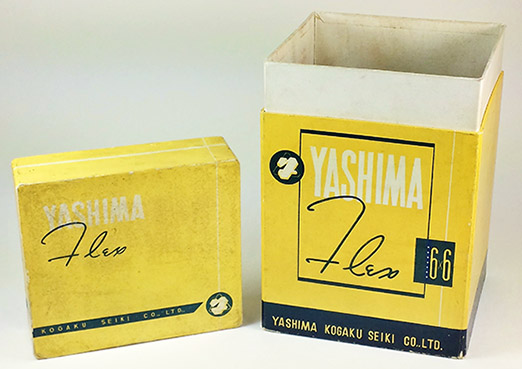
(Images courtesy of Chris Whelan)
The Yashica Flex box without model name on the left belongs to a Yashica Flex model B for sale as a complete kit with camera, case and matching lens cap. There are three examples in my database but a later camera features “Model B” (other sides not visible):
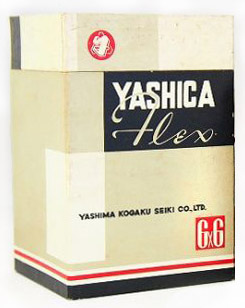
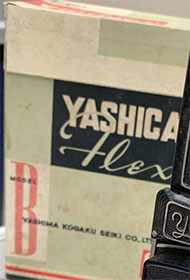 (Detail from larger web image)
(Detail from larger web image)
They are surprisingly similar to the Yashica Flex model S box below and is further evidence that they were contemporaries rather than successive releases. Differences of the left example compared to the model S box are that there is no model name and it is bereft of the “Manufacturers Yashima Kogaku Seiki Co., Ltd. Tokyo Japan” on the left end of the Yashica Flex S box (could be on another part of the box). The rear panel of the model S box is plain without text or graphics except for continuation of the white, red and black bands.
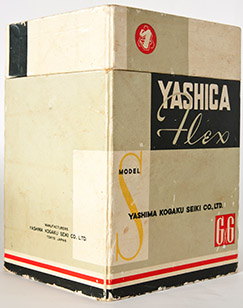
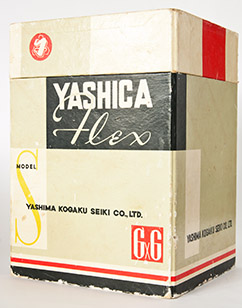
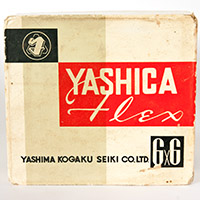
The boxes for the Pigeonflex, Yashima Flex and Yashica Flex models B and S are very rare. I have seen two Pigeonflex and Yashima Flex boxes and three Yashica Flex B boxes without model name, one with, all on Japanese auction sites. My model S box belongs to one of the earliest Copal shutter versions in my database and was for sale in Australia, a second has been found on a Japanese auction site with the earlier NKS-FB shutter version of the camera.
Several slightly later Yashicaflex model S cameras have been found with predominantly black boxes. The cameras have the new type body already. The example below belongs to Chris Whelan but I do want to acknowledge that eBay seller Kathryn went out of her way to provide me a photo of hers first (also subsequently owned by Chris Whelan):
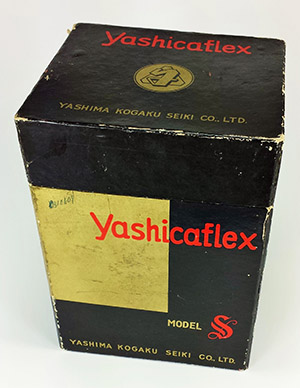 (Image courtesy of Chris Whelan)
(Image courtesy of Chris Whelan)
The new box was probably part of a marketing strategy related to the change from the two word form of “Yashica Flex Model S” to the single word form of “Yashicaflex Model S” to match its new A series contemporaries. In the same way as the first box was remarkably similar to the Yashica Flex Model B example, the new box is almost identical to the Yashicaflex Model AS-II type, marked “Model AS”, discussed a little further below.
The Yashicaflex model A box came with a Yashicaflex A-I which is the first in my database with the new body type but still with cable release shutter (probably from early to mid-1955). Although it is relatively rare for cameras to be found with their box, this box is amongst the more common found on auction sites.
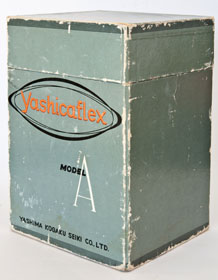
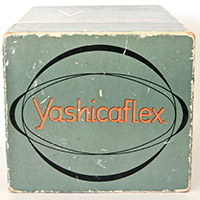
In export markets, the Yashicaflex A-II had its own box which was very similar but the background colour is a bright blue, the oval pattern around the red “Yashicaflex” is grey as is the other text, except “AII” which is white (no hyphen whereas the hyphen is usually there in documents):
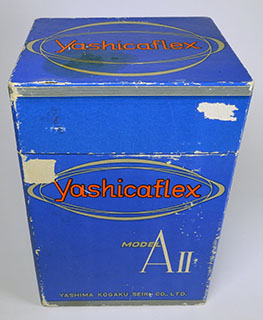
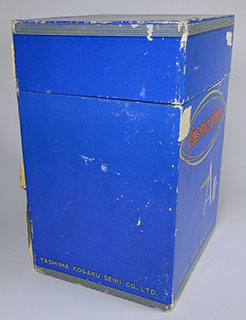
(Images courtesy of Chris Whelan)
I have found at least twelve Yashicaflex A-IIs with the “Yashicaflex model A” box instead of the A-II box. At least ten were complete with original cases, at least three with guarantee papers one also with outer box with matching serial numbers and I think that most, maybe all, were from Japanese sites. Given the number, the kits would not have been assembled by collectors and I think that in Japan, both models shared the same box. That would suggest that in Japan, the A-II was simply called the “Yashicaflex model A”. The only A-I models I have found in Japan are very early Y.S.K. shutter types (I have actually found a later one but that had the feet focusing scale of an export model). The A-I is found with mainly focusing scales in feet whilst the A-II is mostly metric and very common in Japan. So in the domestic market, the A-I was released but disappeared in a month or two leaving only the A-II. From a marketing perspective, I think that it made sense to advertise the camera as “Yashicaflex Model A”. This seems to be confirmed by the Japanese language booklet Yashica Flex Photography and a 1956 brochure (I have found no early Japanese documents with mention of “A-I” or “A-II”). Also, there are a number of Japanese guarantee documents that refer simply to the “Yashica Flex Model A” (in two word form - this was still a transition period) and at least two are definitely for A-II cameras and I suspect all are. This earliest example was acquired by contributor Leigh Harris together with the matching A-II camera:

(Document image courtesy of Leigh Harris)
Boxes marked “Yashicaflex Model AS” have been a conundrum for me. Except for name, they are identical to the later black and gold Yashicaflex model S box above. I have photos of two Yashicaflex AS-II examples (like the model S, with in-built exposure meter and released in late 1954) for sale in the US together with their black and gold boxes and appropriate English language user manuals (“Yashicaflex Directions for use Model A & C” in one case and the earlier “Directions for using Yashica Flex Model AS” for the second camera). The first example also has a guarantee certificate in English as expected since this is mainly an export model. There is no “II” on the boxes possibly because it was also intended for the red window version Yashicaflex model AS-I (mentioned in literature but no example found yet):
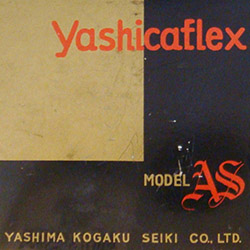 (Detail from larger web image)
(Detail from larger web image)
I also have photos of seven other boxes of the same style, at least five and probably all from Japanese sites. The Yashicaflex AS-II does not appear to have been sold there. Six of the boxes are pictured with the later 1957 Yashicaflex AS (new model) with Citizen MXV shutter and control wheels (i.e., apart from name, no direct relative of the AS-II) and three have user manuals for the “Yashica Model AS” (use of the “Yashicaflex” nameplate whilst marketed as “Yashica” is discussed elsewhere). One also has a guarantee certificate and this time it is in Japanese as would be expected for a domestic model. In summary, each of the seven boxes is supported by either a photo of a Yashicaflex AS (new model) and/or user manual for that camera. Seven examples versus two. On that basis, the later Japanese domestic model wins out but could both models have used the same boxes even though the release dates were three years apart? I have suggested elsewhere that the naming of the Yashicaflex AS (new model) could have involved some “retro” marketing.
It has taken me an embarrassingly long time to realise that in line with this thinking, there are two subtle differences. This is one of the Yashicaflex AS (new model) boxes from Japan:
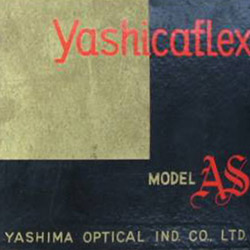 (Detail from larger web image)
(Detail from larger web image)
The “Yashicaflex” font is slightly different but note the change in company name from the Japanese “Yashima Kogaku Seiki Co., Ltd.”, on the model S and AS-II boxes above which had been in use by Yashima since June 1953, to the Anglicised form on the lower box, “Yashima Optical Ind. Co., Ltd.”, of the change to Yashima Kōgaku Kōgyō Co., Ltd. in 1956. So clearly, none of the Japanese Yashicaflex AS (new model) examples should have the earlier box, and that is indeed the case. However, as there is clear evidence that the model AS-II lasted until the middle of 1957, it has been probable that one may have turned up in one of the “new” boxes. And eventually, it has! This AS-II camera also usefully has a JCII tag with January 1957 date stamp and a Belgian customs document dated 30 July 1957. The box is below:
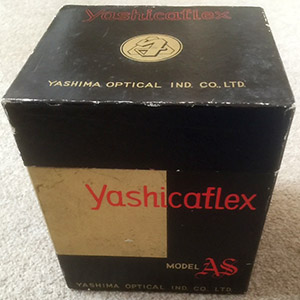
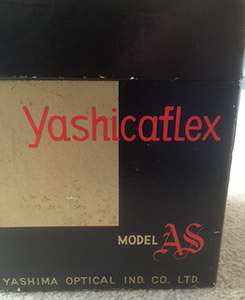
(Images and camera details courtesy of Callum Colville)
So in summary, the earlier “model AS” boxes can only belong to a model AS-II (or AS-I if one is ever found) but the later boxes can belong to either a post 1956 model AS-I/II or any AS (new model).
The Yashicaflex C box has a silver lid which on one side has a large orangey-red rectangle with white Japanese characters “ヤシカフレックス” (“Yashicaflex”) and “Model C” in English next to it. Then there is a white band with prominent “Yashicaflex” in black on two sides, the same size orange band with only “Model C” on one side and another silver band on the bottom. Just as with the model AS boxes, earlier boxes feature the maker name “Yashima Kogaku Seiki Co., Ltd.” whereas later boxes from sometime in 1956 onward have “Yashima Optical Ind. Co., Ltd.” As far as I am aware, the Yashicaflex C box is the only one to feature any prominent Japanese characters:
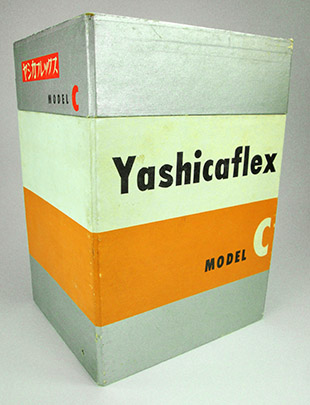
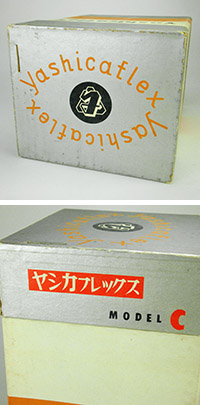
(Images courtesy of Chris Whelan)
The box below left belongs to the second last Yashica Rookie in my database, however it is the same as all the others. The construction of this box confuses me. The top of this box is severely damaged but it looks like a flap type lid - it's not. In fact the box seems to be built much like its contemporaries but without a lid at all! It may be be that the whole box lifts off an inner box - I have added photos of a couple of other boxes which may give a clue:
.jpg)
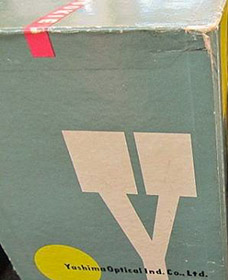
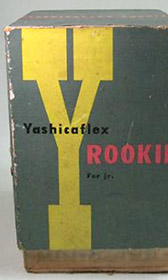
(Left image courtesy of Sandu Baciu, others are detail from larger web images)
Here we have the Rookie outer box in company with a Yashica A type from perhaps only marginally later (the Yashica A was released 6 to 8 months after the Rookie):
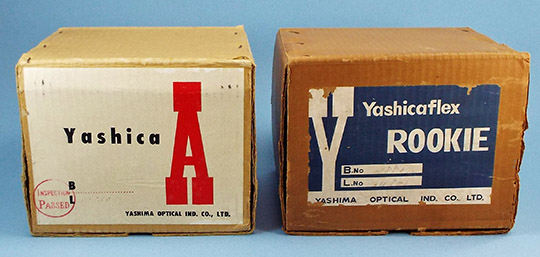
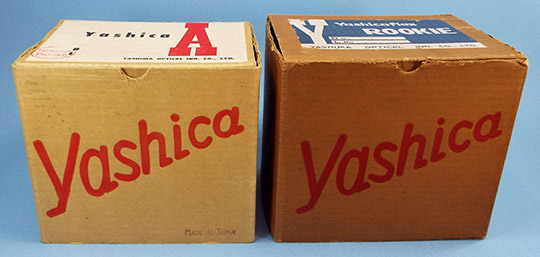 (Pair of images courtesy of Chris Whelan)
(Pair of images courtesy of Chris Whelan)
Contributor Chris Whelan has provided the following measurements:
Yashica Rookie: 152 grams 193mm x 150mm x 172mm
Yashica A: 157 grams 187mm x 150mm x 164mm
Note that both the Rookie inner and outer boxes are marked “Yashicaflex” on the side, introducing a two year period from 1956 to 1958 where Japanese domestic market models used both names. After the Rookie, export models were called “Yashica” and domestic models had “Yashicaflex” on the nameplate but advertising used “Yashica” and boxes displayed both names. The “For Jr” is discussed in the Rookie entry.
The Yashicaflex A2 has a box with plain peach-salmon background. Note that the lid is marked “Yashicaflex” whilst the box is marked “Yashica”:
.jpg) (Detail from larger web image)
(Detail from larger web image)
Although already hinted at by the earlier Rookie, the Yashicaflex A2, Yashica A, C and LM, all released in late 1956, set a common graphics style for 66 model boxes until the early 1960s. The main distinguishing differences in this period are the colours of the plain background and model names, e.g. the silver Yashica LM box has a red “L” and a green “M”. The yellow Yashica A box has large red, blue and white “A”s in different places. At least three Japanese market Yashicaflex A (New Model) cameras (marketed as “Yashica A” in Japan) and two Yashica A III cameras (Japanese market Yashica A without hood logo) have been found with the export market Yashica A boxes - it looks like these were shared between all three models:
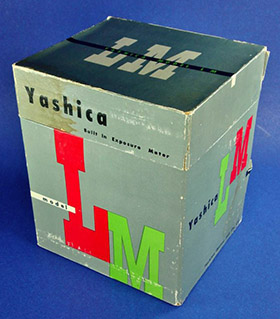
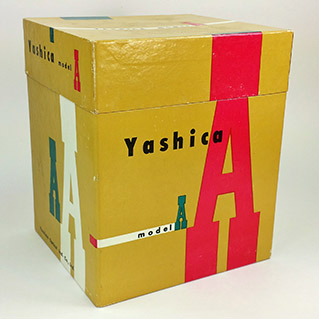
(Images courtesy of Chris Whelan)
The Yashica C box is a light grey-tan colour with a blue strip across the top and a pinky-red “C”:
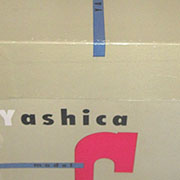 (Detail from larger web image)
(Detail from larger web image)
The Yashicaflex B (new model) box is red and fairly plain in comparison with one prominent “B” on one face and two on another and the text generally alternating between white and black.
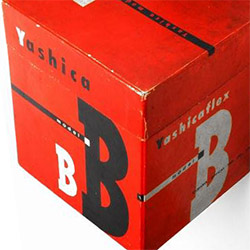 (Detail from larger web image)
(Detail from larger web image)
Reversed with the Yashicaflex A2 box further above, one side of the lid has “Yashica” which together with the box reads “Yashica model B” whilst the box is marked “Yashicaflex”. What we outside of Japan know as the later Yashica B (Yashicaflex A in Japan) has a completely different colour scheme:
(Image courtesy of Sumanta Chandra)
The advertising of Japanese market Yashicaflexes as “Yashica” is discussed elsewhere.
In most photos, the first type Yashica D boxes look pink, contributor Chris Whelan describes his box as “pinkish gray”. It has green, black and yellow “D”s in different sizes:
.jpg) (Image courtesy of Chris Whelan)
(Image courtesy of Chris Whelan)
This one found with a February 1961 camera (i.e., towards the end of this style box), is described as a “warm mid-grey” by correspondent Tim Samuelson:
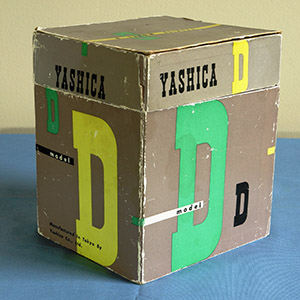
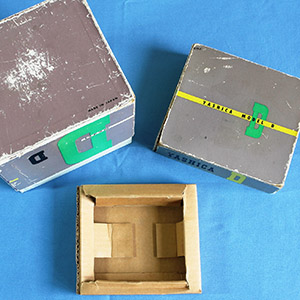
(Images courtesy of Tim Samuelson)
I don't know if the difference is lighting, or a subtle variation.
Below are 1957 Yashica-Mat (with Lumaxar 80 mm lenses) and 1960 Yashica Mat-LM boxes:

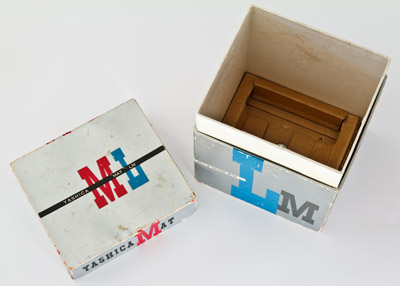
Construction still appears to be the same as the Yashica Flex S and earlier boxes. The silver background and graphics style of the Yashica Mat-LM box closely match the four years older Yashica LM box except for its red and green “LM”. Note the bottom cardboard packing piece insert inside the open box and also with the Yashica D box above - for some reason, these are rarely found. The top and bottom inserts from a Yashica A box are the only ones that I have seen together as a pair:
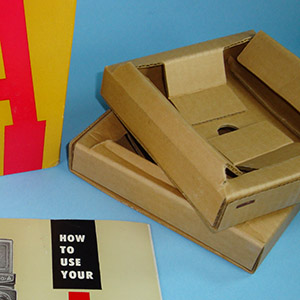 (Image courtesy of Chris Whelan)
(Image courtesy of Chris Whelan)
Below is the external distribution box for an early 1957 Yashica-Mat box (camera with Lumaxar 75 mm lenses) and one for the 1959 Yashica Auto:
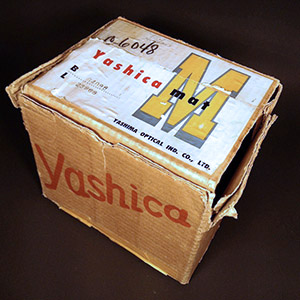
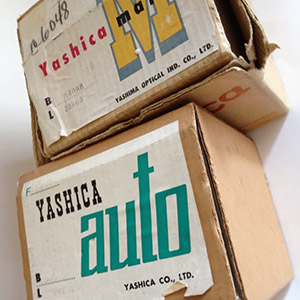
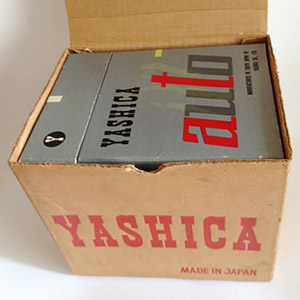
(Images courtesy of Sandu Baciu)
Below is another example of a Yashica Auto internal box. It and its colours are identical to above, just a different side is shown:
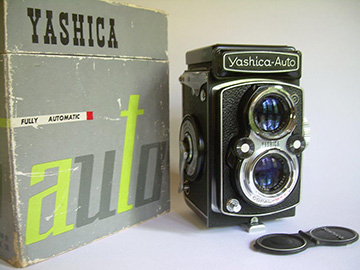
(Image courtesy of Leigh Harris)
Boxes, including outer boxes, for the 44 series are similar to their larger siblings but the graphic designs are a little different, e.g. there are no narrow bands across the lids as on their 66 cousins. The Yashica 44 box is dark grey and relatively plain except the word “Yashica” is spread along the sides of the lid and each letter sits in its own little rectangle of bright colour:
 (Image courtesy of Chris Whelan)
(Image courtesy of Chris Whelan)
Here is one for a Yashica 44A:
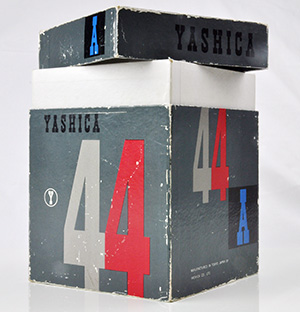 (Image
courtesy of Göran Årelind)
(Image
courtesy of Göran Årelind)
The boxes are a little smaller but not by as much as perhaps expected. Box for Yashica 44LM:
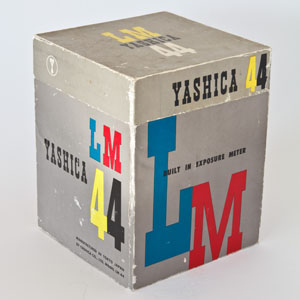
.jpg)
Given the empty space inside these boxes, it would be easy to think that one size would fit all 66 models and another for all 44 models but not so. These are the comparative sizes, remembering that the Yashica Flex S and Yashicaflex A boxes were from a similar period:
- Yashica Flex S: 132 mm x 119 mm x 181 mm
- Yashicaflex A: 130 mm x 115 mm x 185 mm
- Yashica Mat-LM: 153 mm x 139 mm x 178 mm
- Yashica 44LM: 128 mm x 128 mm x 161 mm
Modern Product Box 1958 to 1986
Whilst the original sturdy boxes with lids carried through into the early 1960s for other models, including the new Yashica Mat-LM, it appears that the 635, released in 1958, was the first to receive a simpler unlined, folded, thin cardboard inner box with opening flap. Basically, modern throw-away packaging. The image below is taken from the cover of a 1958 Japanese brochure (see Brochures page, note the other TLR boxes are still the first type with lids). The brochure clearly implies that the 635 is supplied with a “compartment case”:

The 635 is unique in that it is the only model available with either a kit case, or as Yashica called it, compartment case, and/or ever-ready case (until 1964, 635 ever-ready cases were marked “Yashicaflex”). Many ads and brochures advertise “compartment case included” whereas with other models, the ever-ready case was advertised as an extra even though it may have been compulsory. Except for the last 1970s user manual, the compartment case is featured in manuals rather than the usual “how to remove the ever-ready case” for other models. I have seen one presentation boxed 635 with a compartment case in a very complete looking kit with papers etc. I have also seen the presentation boxes with 635s with ever-ready cases, even early ones, but of course these may have originally been supplied with a compartment case which was subsequently abandoned.
This set is for a 1963 Yashica 635 that was for sale with its compartment case and outside box but no presentation box - there would have been one originally.
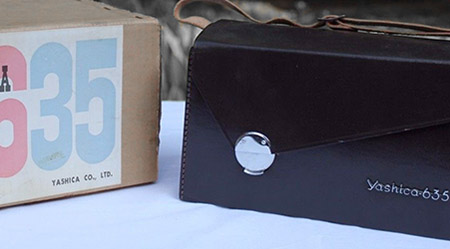 (Detail from larger web image)
(Detail from larger web image)
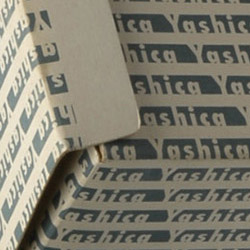
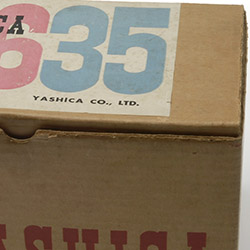
(Detail from larger web images)
Below are two views of Chris Whelan's rather nice example.
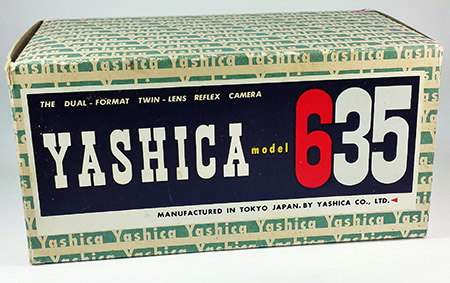
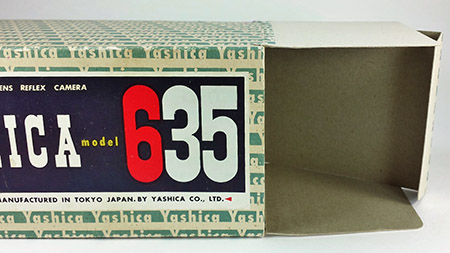
(Above 2 images courtesy of Chris Whelan)
Other cameras then adopted the new style of box construction with the earliest examples in my database being from 1963. These still use the colours and graphics from the original type boxes. The first box belongs to a Yashica Mat-LM from June 1963. The bottom packing shown is now polystyrene foam instead of the earlier folded cardboard (the earlier 635 boxes are not known) and the external distribution box has become a simple open ended sleeve (inner box shown on its side):
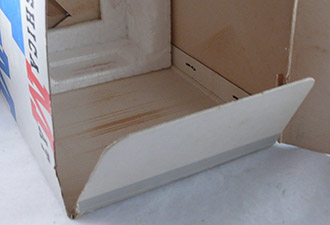
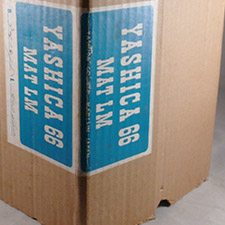 (Detail from larger web images)
(Detail from larger web images)
The second box belongs to a Yashica D from December 1963:
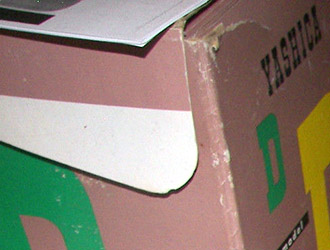 (Detail from larger web image)
(Detail from larger web image)
The third belongs to an April 1964 Yashica A, with its typically 1956 graphics on yellow background:
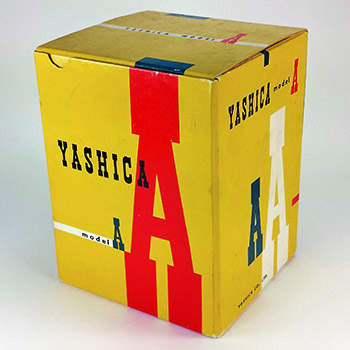 (Image courtesy of Chris Whelan)
(Image courtesy of Chris Whelan)
The 44 models seem to have followed suit. This Yashica 44LM box belongs to a November 1964 camera, presumably there is also a 44A version:
 (Detail from larger web image)
(Detail from larger web image)
The next variation was the adoption of a standard graphic style across all models, namely a horizontal red and blue band repeated across the top and an adhesive wrap around label for model name/ headline specs (a March 1964 Yashica 635 still uses the first type box, the model be an exception). My assumption was that the background colour was white or light grey and maybe had yellowed somewhat with age but it actually is a pale yellowy cream, 100% confirmed with the Yashica D version further down and also noticeable with the Yashica Mat-EM below. The 1964 Yashica E version looks more pale in the photos but the top flap edge shown in another photo is clearly the same two tone yellow/white as the Yashica D box:


(Images courtesy of Tom Chandler)
Note the two stapled seams on the back. The 1964 Yashica Mat-EM distribution sleeve is much like the Yashica Mat-LM type:

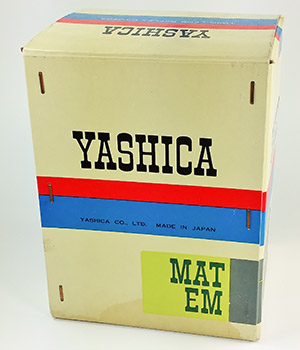
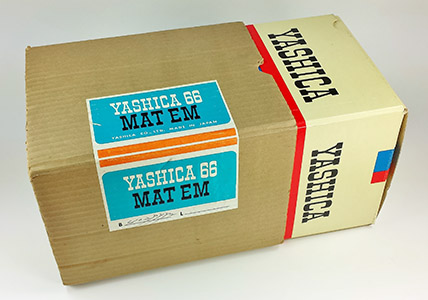 (Images courtesy of Chris Whelan)
(Images courtesy of Chris Whelan)
This December 1964 Yashica A box is similar but features “Yashica” in the new font already and a single stapled seam down the back:
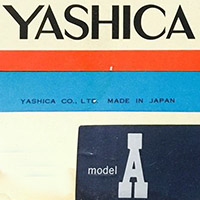 (Detail from larger web image)
(Detail from larger web image)
This January 1965 Yashica D box is the same as the Yashica A box but note the cream colour - it only makes sense if all the boxes from this period are the same:
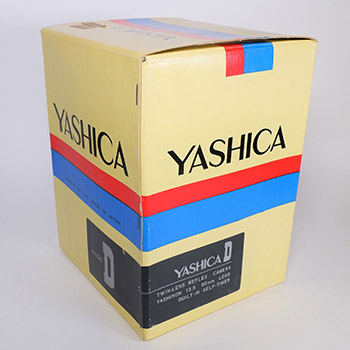
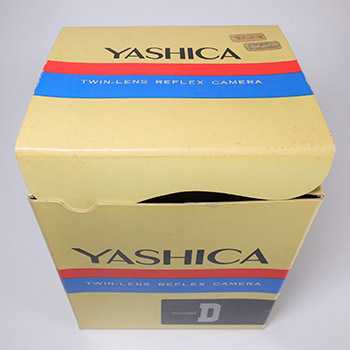
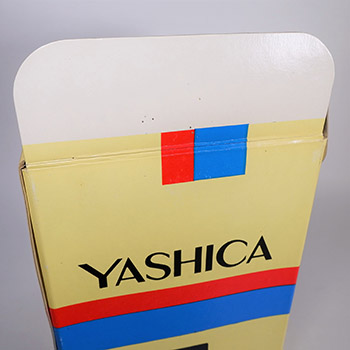
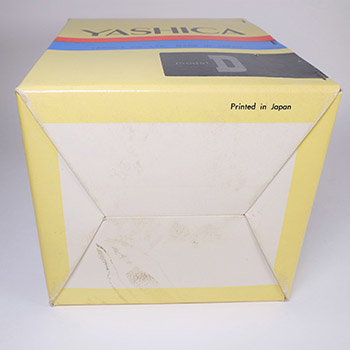
(Images courtesy of Chris Whelan)
Later in 1965 already came the “66” labelled boxes. The one for the 635 changed to vertical orientation from its first type but is taller than its contemporaries (it is unknown whether there is a 635 version of the red and blue stripe type). All boxes of this type, including the taller 635 box, use the same text, colour, and graphics with the model details on a wrap around adhesive label (similar concept to the previous arrangement). The label is aligned over a black background strip. On this example, the edge is visible near the “A” and note the misaligned triangle on this box and the first 635 example below:
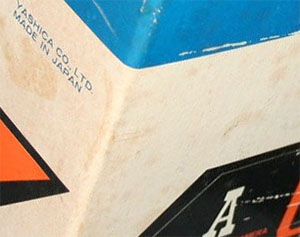 (Detail from larger web image)
(Detail from larger web image)
At one end of the label is the model and an inverted orange triangle and at the other end, the model and orange “66” . Different sides of two otherwise identical 635 boxes are shown:
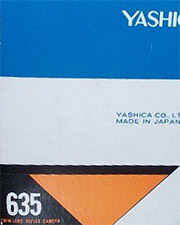
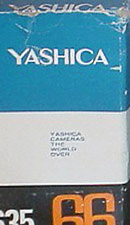 (Detail from larger web images)
(Detail from larger web images)
Below left is the Yashica Mat-EM “66” style box introduced after the first red-blue band type further above. Next to it is a similar Yashica-Mat and 1966 (from its camera serial number) Yashica A boxes:
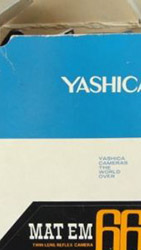
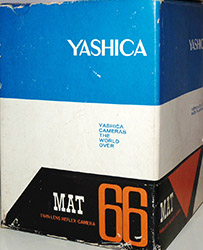
 (Detail from larger web images)
(Detail from larger web images)
There is also an April 1965 Yashica D example in the same style and colours palette, however, the later Yashica D example below (exact date unknown) introduces colour coding for the different models. Next to it is a Yashica 24 (introduced late 1965) box which has a light blue “66” and triangle:
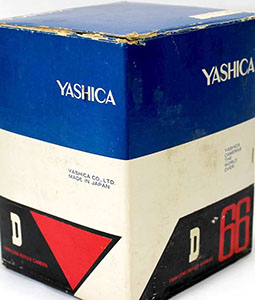
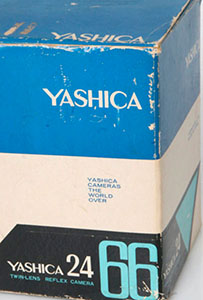 (Detail from larger web images)
(Detail from larger web images)
The blue top third of the Yashica D box is darker and more intense than other examples above and below as is the red colour coding compared to the sleeved example below so is more likely to be a feature of the photograph than reality. Except for the unique Yashica Mat-124G boxes, the uniform colour scheme and colour coding of the triangles and “66” for each model is now maintained until the end.
The later Yashica 12 box below for a camera from May 1967 has a slightly different greeny blue colour code for the name and triangle than the 24, the difference is more obvious with the user manuals. Although from the side, the same in appearance as its predecessors, it is in fact a vertical sleeve with more in common with the following horizontal sleeve types including a split polystyrene foam case (although the case is split the same as the ones below, it stands on its end). Also, the name band and colour coded triangle are no longer on an adhesive label. The back seam is not visible but I suspect that there are no staples:
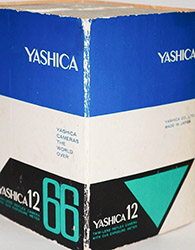 (Detail from larger web image)
(Detail from larger web image)
All cases from the same period possibly feature the same style and construction but I have yet to find any others.
With the next change, the Yashica Mat-124 and very late examples of the Yashica D “66”, Yashica 635 “66” and Yashica-Mat “66” continue with the established colour scheme (shown in that order below, the Mat being the unnamed purple example) but have a horizontal orientation similar to the following Yashica Mat-124G box, except like the Yashica 12 “box” above, the box is a sleeve around a horizontally split polystyrene foam case, i.e., there are no cardboard ends. As far as I can tell, there does not appear to be any use of staples or adhesive model name labels found on boxes immediately preceding the Yashica 12 box:
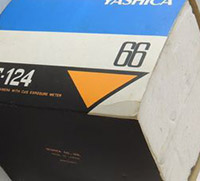
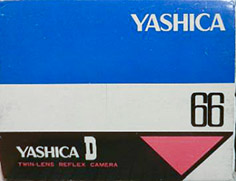
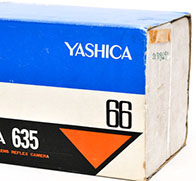
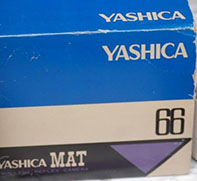
(Detail from larger web images)
Late Yashica A version, the camera it belongs to has a September 1968 serial number (last one in my database, details in Yashica A). The colour coding may be olive green:
.jpg) (Image courtesy of Jon Allyn)
(Image courtesy of Jon Allyn)
The Mat-124G box is back to being a proper box, albeit thin and cheap with simple flap lid. It has the camera laid on its back in split polystyrene foam packing. The example below is from a late camera, estimated from 1985, with Kyocera branding on the bottom:
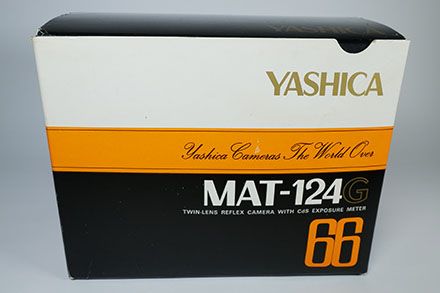
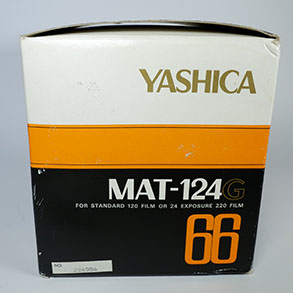
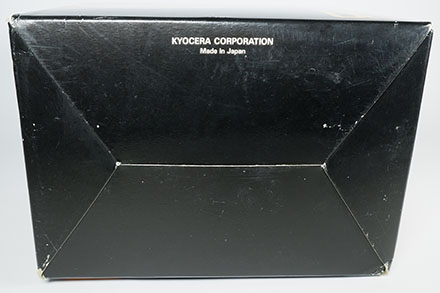
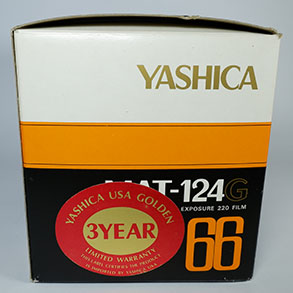
(Images courtesy of Chris Whelan)
Apart from the branding, the only variation I am aware of is construction. Earlier boxes used two stapled seams (left below) and newer boxes featured a single glued seam (right below):
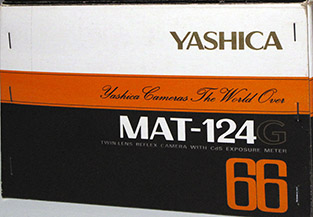
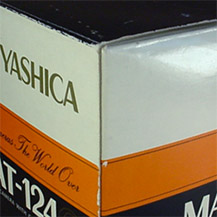
(Detail from larger web images)
Both boxes have a label with body serial number at one end. That suggests to me that there were no external boxes by this time, although they could well have disappeared earlier.
The newer style boxes, particularly the later ones with the cameras enveloped in polystyrene foam, undoubtedly provided excellent protection for new cameras but they were not designed for ongoing storage like the earlier ones (whether real intention, or simply an element of inherited Rollei tradition). In fact, with the changing construction and attention to detail, we can see how Yashica was trying to cut costs. Accordingly, most were discarded with the wrapping paper and few have survived. Mat-124G examples do turn up with their cameras from time to time but with over 1/2 million produced over 16 years, that is not surprising. It is also the most recent model plus given the number of mint examples for sale, I suspect that some were bought simply to collect before the inevitable end.
